Sites: news | india | latam | brasil | indonesia
Feeds: news | india | latam | brasil | indonesia
topic: Traditional Medicine
Social media activity version | Lean version
Traditional healers in Philippines keep their ‘forest pharmacy’ standing
- The island of Siquijor in the southern Philippines is famed for its traditional healing practices; less well known is the role its healers play in conserving the island’s forests.
- Traditional practices and beliefs encourage respectful and sustainable harvest of medicinal plants.
- The island’s healers’ association also collaborates with researchers and a government reforestation initiative to monitor and cultivate medicinal trees in the island’s forests.
Ghana’s medicinal plants, the ‘first aid’ for communities, are under threat
- Forest communities in southwestern Ghana use 70 species of medicinal trees to treat up to 83 ailments, according to a recent study.
- These plants contain high levels of bioactive compounds with pharmacological benefits, but many are also threatened by factors including overharvesting and agricultural expansion in the area that drives large-scale deforestation.
- Due to a lack of access to Western medicine and cultural perceptions, traditional medicine is the primary source of treatment for many forest-fringe communities.
- The authors say government-led conservation programs and preserving traditional knowledge is important to conserving these medicinal tree species.
Traditional healers push for recognition and licensing of age-old Himalayan practice
- Traditional healers from Nepal’s Himalayas are trying to preserve Sowa Rigpa, an ancient medicinal system based on ethnobotany, which has been gradually disappearing as youths move to urban areas and the species used in medicinal formulas are at risk.
- Sowa Rigpa includes traditional knowledge of the properties of hundreds of endemic species and local varieties of plants, fungi and lichens, as well as dozens of types of minerals.
- Two associations of Sowa Rigpa healers are trying to get the medicinal practice officially recognized by the Nepali government as a way to protect it, and are seeking official medical licenses for new practitioners.
- The healers, known as amchi, are partnering with a university, NGO and the government to further research, conserve and find potential substitutes for threatened plant and animal species used in Sowa Rigpa.
For Vietnam’s rare reptiles, lack of captive populations may spell doom
- As an epicenter of biodiversity, Vietnam hosts a wide array of reptile species. But new research shows that many species that occur nowhere else on the planet are poorly known and lacking protection.
- The researchers also found that many of Vietnam’s rarest species are absent from the world’s zoo collections and conservation breeding programs, risking their disappearance forever should their wild populations collapse.
- They call on conservationists and authorities to focus on conservation measures to protect the country’s most vulnerable reptiles, including establishing assurance populations that could be used in the future to repopulate areas of wild habitat from which they have been lost.
Bangladesh ‘Village of Herbs’ profits from planting rather than cutting trees
- According to the World Health Organization, 88% of all countries are estimated to use traditional medicine; more than 40% of pharmaceutical formulations are based on natural products, and many landmark drugs originated from traditional medicine.
- According to the Bangladesh Agricultural Research Institute, there are 722 species of medicinal plants in Bangladesh.
- Locals who once cut down trees are now actively planting and cultivating medicinal trees. Large pharmaceuticals, Ayurvedic, and Unani medicine manufacturers collect raw materials from this market.
‘A psychedelic renaissance’: How hallucinogens can aid conservation
- Mind-altering substances from plants and fungi, such as ayahuasca, are having a moment in popular culture, but they’re also starting to gain attention from the medical and conservation communities.
- Famed ethnobotanist, conservation advocate and best-selling author Mark Plotkin joins the Mongabay Newscast to talk about what he dubs the “psychedelic renaissance” and how this moment can be a hook to inspire conservation.
- Many Amazonian plants and fungi have medicinal properties understood by traditional healers, but can also be frequently abused if applied improperly.
- Plotkin talks about the importance of protecting this traditional ecological knowledge, both for the responsible application of these plants, and for realizing their potential as a vehicle for conservation.
Local coverage of Nepal’s ‘Himalayan Viagra’ harvest lacks eco focus, study says
- Yarsa gunbu, better known outside Nepal as the Himalayan Viagra, accounts for two-fifths of the country’s non-timber exports.
- Every year, hundreds of thousands of Nepalis head for the hilly regions to harvest this fungus-mummified caterpillar larvae from the wild, leaving schools, farms and entire villages deserted.
- A new study analyzing domestic news coverage of yarsa gunbu has found that much of the reporting focuses on the scale of the harvest and the exorbitant prices that the commodity can fetch.
- The study authors have called on the media to emphasize other aspects of the yarsa gunbu trade, including the ecological cost from harvesting, and the social cost when schools are bereft of teachers.
Documenting Nepal’s plant-based medical tradition: Q&A with Ram Prasad Chaudhary
- Ram Prasad Chaudhary is an ethnobotanist who for decades has studied how various communities throughout Nepal use medicinal plants and pass on this knowledge.
- One pattern he’s noticed is that communities living at higher altitudes tend to make more use of herbal remedies than those living on the plains, with the latter having easier access to Western medicine — a situation he calls ironic.
- With younger generations of Nepalis increasingly viewing ethnobotanical traditions as superstition, Chaudhary says it’s imperative to instill in them the belief that the practice is based on centuries of knowledge generation.
- He also points to the case of China, where the practice of both Western and traditional medicine is complementary rather than competing, saying this is “the best way to go about it.”
Myanmar wildlife trade remains opaque, despite focus on border hubs
- Myanmar supports some of the last refuges of rare and threatened species, such as tigers, leopards and pangolins, but lax law enforcement and porous borders make it a hotbed of illegal wildlife trade, imperiling the country’s remaining biodiversity.
- While a lot is known about flagrant trade in notorious markets in towns bordering China and Thailand, much of the trade with Myanmar remains opaque, new research shows.
- One-quarter of prior studies on the country’s wildlife trade have focused on just two border trade hubs, while little is known about patterns of domestic wildlife trade and consumption.
- The researchers call on authorities to establish a central wildlife crime database to promote data sharing of enforcement and research knowledge; further research on poaching motives; and improved enforcement of existing wildlife laws.
Indigenous agroforestry dying of thirst amid a sea of avocados in Mexico
- A rich tradition of cultivating and collecting medicinal plants in Mexico’s Michoacán state is at risk, as the Indigenous community behind it loses access to water.
- Avocado farms–mostly supplying the U.S. market–dominate water resources in the town of Angahuan, forcing Indigenous P’urhépecha healers to buy clean water by the gallon from shops to keep their medicinal plants alive.
- These healers, known as curanderas, have for generations grown a wide variety of such plants in agroforestry gardens that also combine fruits and vegetables, timber trees, and flowers.
- The P’urhépecha healers are resisting the impacts of avocado farms by planting trees in the hills to build up water resources while launching a natural pharmacy business in town, efforts for which the collective has already won an award from the state government.
Saving medicinal plants a village cause in Indonesia
- Residents of the Sumatran village of Muara Jambi are working to preserve their ancient practice of cultivating and using medicinal plants.
- The village is also home to an ancient Buddhist temple complex that may be linked to the medicinal plant tradition, but some fear government plans to restore the site could threaten the plants growing there.
- Other threats come from oil palm plantations and coal mines operating nearby.
‘A risky business’: Online illegal wildlife trade continues to soar in Myanmar
- A new report from WWF shows that trade in protected wild animals and their body parts in Myanmar via the social media platform Facebook rose by 74% in 2021 compared to the previous year.
- The scale of the online trade, the purpose of the trade, and the species seen in the trade are all of major concern in terms of impacts on biodiversity and the potential risks to public health from disease transfer, according to the report.
- Posts advertising live civets and pangolins as wild meat, as well as posts referring to their commercial breeding potential are a particular concern, argue the report authors. Both species are considered to be potential vectors in passing zoonotic diseases to humans.
- The report calls on online platforms to do more to monitor their platforms and take swift action, and for greater involvement and collaboration from multiple sectors to strengthen enforcement, disrupt the illegal wildlife trade, and increase awareness of the health risks posed by illegally traded wildlife.
Where trafficked pangolins originate is a puzzle, hobbling efforts to save them
- Trafficking of pangolin parts, especially scales, from Africa to Asia has increased in recent years, while efforts to determine where seized scales originated from have not been able to keep pace.
- These scaly anteaters are one of the most trafficked mammals globally, and trade in all eight pangolin species, four of which are found in Africa, is banned.
- Scientists at the University of Washington who developed a technique using genetic data to pinpoint where ivory originated from and now are trying to replicate it for pangolins.
- Dismantling trafficking networks may not, by itself, protect dwindling pangolin populations, experts say, as there is a pressing need to understand what is driving the illegal trade.
New study highlights hidden scale of U.S. illegal tiger trade
- A new study highlights the previously underestimated role of the U.S. in the illegal tiger trade: According to newly compiled seizure data, tiger trafficking in the U.S. from 2003 to 2012 corresponded to almost half of the global tiger trade reported for that period in prior studies.
- By analyzing hundreds of U.S. tiger trafficking incidents, the researchers uncovered noteworthy routes from China and Vietnam into the country, with the vast majority of seizures involving traditional medicines.
- They also found significant legal trade in captive-bred tigers into the country, mainly for use in roadside zoos and circuses; experts say the patchwork of U.S. federal, state and local laws that govern the roughly 5,000 captive tigers in the country is insufficient to safeguard them from the illegal trade.
- Experts are calling on U.S. legislators to pass the Big Cat Public Safety Act, a bill that would improve the welfare and protection of tigers in captivity and therefore strengthen the country’s integrity on international tiger conservation matters.
Greater Mekong primates struggle to cling on amid persistent threats: Report
- The Greater Mekong region is home to 44 species of non-human primates, including gibbons, lorises, langurs, macaques and snub-nosed monkeys, several of which were first described within the last few years.
- Habitat loss and hunting driven by the wildlife trade and consumption have driven many of the region’s primates to the brink of extinction, with many species now only existing as tiny populations in isolated, fragmented pockets of habitat.
- Experts say controlling the illegal wildlife trade is complicated by the presence of legal markets for primates, often for use in biomedical research.
- Despite the challenges, conservation action at local levels is achieving results for some primate species in the region while also enhancing livelihoods and ecosystem services for local communities.
Tiger farms doing little to end wild poaching, Vietnam consumer study shows
- More than 8,000 tigers are kept in captivity in China, Laos, Thailand and Vietnam in commercial facilities ranging from residential basements to licensed venues operating under the guise of tourism, and battery-farm operations holding hundreds of tigers.
- Evidence shows that captive tigers and their body parts enter the legal and illegal trade, where they perpetuate the demand for tiger-based traditional medicines and decorative curios, primarily in China and Vietnam.
- A new study that investigates the motivations of consumers of “tiger bone glue” in Vietnam reveals that consumers prefer products from wild tigers and would carry on purchasing illegal wild products even if a legal farmed trade existed.
- The findings back up calls from conservationists and wildlife trade experts to phase out tiger farming entirely since it doesn’t alleviate pressure on wild tigers, and only encourages the consumption of tiger parts.
Global ayahuasca trend drives deforestation in Brazil’s Acre state
- The growing popularity and increased commercialization of ayahuasca, a psychoactive brew, may be harming the Amazon forest where its two key ingredients grow.
- In the Brazilian state of Acre, regulations in place since 2010 have done little to curb the threats to the native Psychotria viridis shrub and the Banisteriopsis caapi vine.
- Traditional proponents of ayahuasca say the absence of meaningful environmental safeguards leaves the authorities powerless to act against the outside forces clearing rainforest for these increasingly rare and valuable plants.
Study confirms anti-inflammatory property of traditional Samoan remedy
- Aided by traditional Samoan healers, researchers isolated the bioactive compounds from the leaves of a small, tropical tree called Psychotria insularum.
- The leaf extract, along with the isolated compounds, was recently discovered to prevent the production of inflammatory molecules in immune cells as well as ibuprofen did.
- Despite opinions that Indigenous knowledge is merely superstitious, Samoan researchers say it is the product of centuries of empirical testing, careful observation and the conservation of their natural resources.
- Researchers and Samoan traditional healers have set up gardens to protect traditional medicinal plants with therapeutic potential from the impacts of climate change and environmental destruction.
Extinction of Indigenous languages leads to loss of exclusive knowledge about medicinal plants
- A study at the University of Zurich in Switzerland shows that a large proportion of existing medicinal plant knowledge is linked to threatened Indigenous languages. In a regional study on the Amazon, New Guinea and North America, researchers concluded that 75% of medicinal plant uses are known in only one language.
- The study evaluated 645 plant species in the northwestern Amazon and their medicinal uses, according to the oral tradition of 37 languages. It found that 91% of this knowledge exists in a single language, and that the extinction of that language implies the loss of the medicinal knowledge as well.
- In Brazil, Indigenous schools hold an important role in preserving languages alongside cataloguing and revitalization projects like those held by the Karitiana people in Rondônia and the Pataxó in Bahia and Minas Gerais.
Climate change threatens to squeeze out Indonesia’s medicinal plants
- More than half of medicinal plant species in Indonesia won’t be able to grow in most of their current range by 2050 due to climate change, a new study says.
- Researchers say medicinal plant species on the islands of New Guinea, Java and Sulawesi will see the largest reduction in distribution area, in part due to sea level rise in these regions.
- The economic value of medicinal plants in Indonesia, coupled with other threats and a lack of resources for their conservation, makes it urgent that active conservation programs be put in place, the researchers say.
- Medicinal plants are valuable species not only for personal health but also for their economic value as they are traded by local and Indigenous communities.
Traditional healers are preserving their knowledge, and with it, the biodiversity of Brazil’s savanna
- The Brazilian savanna contains almost a third of Brazil’s biodiversity but less than 10% is officially protected and its native vegetation is threatened by a rapidly-advancing agricultural frontier.
- Much of the flora and fauna remain unknown to conventional science.
- A network of traditional healers is at the forefront of finding ways to protect, sustainably manage, and document the biodiversity based on their in-depth knowledge of medicinal plants.
- Experts say that finding ways to value the savanna more, such as through recognizing its immense botanical and pharmacological value, could aid in its conservation.
China still making pangolin-based treatments despite banning use of scales, report says
- A new report has found that medicines containing pangolin scales are still being produced and sold throughout China, despite a recent ban on pangolin scales from the official list of approved ingredients in traditional Chinese medicine.
- According to the report, 56 companies are actively producing and selling 64 medicines containing pangolin scales, and that an additional 165 companies and 713 hospitals have the authority to produce such medicines.
- The only legal way for pharmaceutical companies and hospitals to obtain pangolin scales is through government-registered stockpiles, but conservationists say these stockpiles are poorly regulated and allow for the possibility of illegal trade.
A Philippine tribe’s plant-based medical tradition gets its moment
- A newly published study highlights the importance of medicinal plants that thrive on the ancestral lands of the Manobo Indigenous group in the southern Philippines.
- The Manobos of the highland Agusan region have for generations depended on their vast compendium of ethnomedicinal plants to treat a wide range of ailments.
- The popularity of this folk medicine has spread beyond the members of the tribe, with many of the treatments showing similar properties to established Western medicines.
- Further documentation and study of these ethnomedicinal plants could help in the preservation and conservation of the Indigenous group’s lands, say the authors of the recent study.
Favoring ayahuasca over hospitals, Indigenous Kokama see COVID-19 deaths drop in the Amazon
- The Kokama were the first Indigenous group in Brazil to be infected with COVID-19, and to date there have been more than a thousand confirmed cases and 60 deaths within the community.
- Wary of Western medicine and of the prejudice and neglect they say they suffer at hospitals, the community decided to turn to traditional healing practices, administered by shamans. Their weapon in the fight against the coronavirus is the ayahuasca ritual, considered by the Kokama their most powerful cure.
- In the past six weeks, the community has recorded just four deaths from COVID-19, compared to 56 during the previous two months, when they were still seeking hospital treatment.
- The reduction in the death rate is the result they say they expected when they shunned regional hospitals, many of which have struggled to treat patients in the midst of the pandemic and where indigenous peoples have fared particularly poorly, in favor of their traditional medicines combined with hygiene practices and social distancing.
Illegal trade of Philippine pangolins is surging, report shows
- A new report published by TRAFFIC found that the illegal pangolin trade in the Philippines increased nine-fold in the last two years, with the authorities confiscating an estimated 6,894 pangolins between 2018 and 2019.
- Data included seizures of pangolin scales and retrievals of live pangolins that escaped from wildlife traffickers.
- TRAFFIC researchers also conducted ad hoc surveys around Manila to discover pangolin meat being served at restaurants and shops selling pills made from pangolin derivatives.
- It’s estimated that Philippine pangolins, a critically endangered species of the pangolin, have declined up to 95% in the last 40 years.
Indigenous Ashaninka launch fundraiser to help Amazon neighbors amid pandemic
- In early July, the Ashaninka indigenous people launched a fundraising campaign to encourage food production in communities living near the Kampa do Rio Amônia Indigenous Territory, in the Brazilian state of Acre.
- The “Ashaninka for the Peoples of the Forest” campaign plans to raise 1 million reais (about $200,000) to distribute food, farming tools and fishing gear to 1,800 local families, both Indigenous and non-Indigenous.
- There have been no reports of any Ashaninka being infected with COVID-19 to date; isolated by barriers they set up in the river leading to their village, they’re surviving on their traditional farming techniques.
- Nearby communities, however, depend on food aid and lack medical care in highly complex cases, prompting the Ashaninka to launch the fundraising campaign out of a sense of duty.
Banned: No more pangolin scales in traditional medicine, China declares
- The Chinese government has banned pangolin scales from use in traditional Chinese medicine, and elevated pangolins to be a level one protected species within China.
- Conservationists say they believe this move will completely shut down the commercial trade of pangolin parts within China and slow the international trade of the species.
- Pangolins are one of the most widely trafficked animals in the world, despite being protected under CITES Appendix I, which bans most international trade.
As COVID-19 rages, Sri Lankans find solace in traditional practices
- Self-isolation measures being adopted around the world in response to the COVID-19 pandemic are nothing new for Sri Lanka’s indigenous communities, who have over generations developed a system of quarantine against infectious diseases.
- Before the scientific discovery of bacteria and viruses, indigenous communities attributed infections and diseases to the power of evil spirits, and relied on herbal remedies and rituals seeking blessings from deities to prevent illness.
- The country’s national greeting, a variant of the clasped-palms stance practiced widely across Asia, is also now being adopted in the West as a non-contact alternative to shaking hands, hugging, and kissing on the cheek.
- Communities are being reminded of the need to align traditional practices with new scientific knowledge to fight outbreaks such as COVID-19.
Shamans in the city: Brazil clinic offers traditional Amazonian treatments
- Created by an indigenous anthropologist, the Centro de Medicina Indígena Bahserikowi offers residents of the Brazilian Amazonian city of Manaus traditional healing and protective treatments by shamans from the Dessana, Tuyuka and Tukano ethnicities.
- Known as kumuã, the indigenous shamans apply the Bahsessé, a type of blessing from the Upper Rio Negro region that evokes the presence of rainforest beings who, according to them, hold all knowledge about humanity.
- In the nearly three years it’s been operating, the center has treated 2,700 people. One of its objectives is to teach the general public about traditional indigenous medicine, a practice that’s losing its foothold in the rainforest.
Chinese government reportedly recommending bear bile injections to treat coronavirus
- The London-based Environmental Investigation Agency (EIA) reported today that a list of recommended treatments for the novel coronavirus disease COVID-19 published by the Chinese government earlier this month includes injections of a traditional medicine called “Tan Re Qing,” which contains bear bile.
- Last month, China adopted a comprehensive ban on trade and consumption of wildlife in response to the growing COVID-19 outbreak, which scientists believe originated in a market in the Chinese city of Wuhan where wild animals and bushmeat are sold. But the ban does not prohibit the use of wildlife products in traditional Chinese medicine or as ornamental items.
- EIA wildlife campaigner and China specialist Aron White noted the irony in the country recommending a treatment that relies on trade in wildlife in response to a global disease pandemic born from the wildlife trade.
For tiger moms, the work-life balance struggle is real, study finds
- For the first time ever, scientists were able to document the behavior of a GPS-collared Amur tiger in the wild for the four months before and four months after the birth of her cubs.
- The study, published in the journal Mammal Research, reveals that the new tiger mom made time for her cubs by abandoning defense of her territory, traveling more rapidly from kills, making fewer but larger kills, and resting less.
- The Amur tiger (Panthera tigris altaica), sometimes referred to as the Siberian tiger, is currently listed as an endangered species on the IUCN Red List.
- Poaching is now the biggest threat to the wild Amur tigers, as tiger parts continue to be in high demand throughout Asia for use as ornaments, in traditional medicine, and as a status symbol.
Nearly extinct vaquita mothers with calves spotted in recent expeditions
- The latest expeditions in the Gulf of California, Mexico, to survey the vaquita, the world’s smallest cetacean, have yielded sightings of both vaquita mothers and calves. This, researchers say, indicates that the mammals are still reproducing despite threats.
- In a survey carried out between August and September, researchers spotted what they say were likely six distinct individual vaquitas.
- During a subsequent expedition in October, researchers say they spotted vaquitas several times, including six different vaquitas in two groups, and three pairs of mothers and calves.
- This news is hopeful, but the mammal’s future is still perilous due to the continued use of illegal fishing nets in its habitat, experts say.
’Rampant’ fishing continues as vaquita numbers dwindle
- An expedition surveying the Gulf of California for the critically endangered vaquita porpoise has reported seeing more than 70 fishing boats in a protected refuge.
- Vaquita numbers have been decimated in the past decade as a result of gillnet fishing for another critically endgangered species, the totoaba, a fish whose swim bladder can fetch more than $20,000 per kilogram ($9,000 per pound) in Asian markets.
- Local fishing organizations in the region say that the government has stopped compensating them after a gillnet ban, aimed at protecting the vaquita from extinction, went into effect in 2015.
Legal and illegal trade negatively impacting survival and wellbeing of Africa’s wildlife: Report
- Released last week by the London-based NGO World Animal Protection to coincide with World Animal Day, the report looks at the “Big 5” and “Little 5” most-in-demand species and how trade in those animals impacts their wellbeing and conservation status.
- Between 2011 and 2015, some 1.2 million animal skins from the “Big 5” African wildlife species identified in the report as being most in-demand — the Nile crocodile, the Cape fur seal, Hartmann’s mountain zebra, the African elephant, and the common hippo — were legally sold.
- More than 1.5 million live animals belonging to one of the “Little 5” African species — the ball python, the African grey parrot, the emperor scorpion, the leopard tortoise, and the savannah monitor lizard — were exported for the exotic pet trade between 2011 and 2015, the report finds.
With new protections, saiga antelope may continue to be a symbol of Central Asia (commentary)
- Saiga antelope are classified as Critically Endangered on the IUCN “Red List” of threatened species. Disease and poaching have taken their toll on this ancient animal.
- With potential disease threats, saiga cannot withstand the additional challenges of poaching and illegal trade. Saiga males are targeted and killed for their horn, which is used in traditional medicine in Asia. With the total remaining saiga population in Mongolia standing at less than 3,000, we are deeply concerned about both illegal trade and any potential commercial trade.
- The majority of the 183 governments that are Parties to CITES gathered this week for their global meeting to regulate or prohibit commercial trade in threatened and endangered species. Given the high demand for saiga horn and this animal’s susceptibility to disease resulting in high levels of mortality across the population, the action taken in Geneva this week to strengthen saiga’s global protection was essential.
- This post is a commentary. The views expressed are those of the author, not necessarily Mongabay.
Nigeria finds itself at the heart of the illegal pangolin trade
- Pangolins have long been hunted for food and traditional medicine. They are traded openly in bushmeat markets in Nigeria and neighboring Cameroon.
- Strong demand from Asia has attracted organized criminal syndicates to set up trafficking networks in Nigeria, and the illegal trade in pangolin parts has gone deeper underground.
- Hunters and traders tell Mongabay that the impact of increased trafficking on pangolin populations is becoming clear as they are increasingly difficult to find in the forest.
- Chinese buyers will pay anywhere between $3 and $20 for a pangolin — a relative fortune for local bushmeat traders. Traffickers can then get as much as $250 for the scales from one pangolin in markets in Asia.
Big cat trade driven by demand for traditional Asian medicine, according to report
- Bones, blood, and other body parts of big cats are made into products such as balms, capsules, gels, and wines that practitioners of traditional Asian medicine believe to be able to cure ailments ranging from arthritis to meningitis, though in fact they’ve been found to have no provable health benefits.
- Even before farmed big cats are killed to feed the demand for traditional Asian medicine, however, they’re treated more like products than living, breathing creatures, according to a report released last month by the London-based NGO World Animal Protection.
- China and South Africa are the world’s biggest breeders of captive cats. China alone is estimated to have between 5,000 and 6,000 tigers in captive breeding facilities, while South African facilities are holding between 6,000 and 8,000 lions and another 300 tigers.
Documentary seeks to tip the scales against illegal pangolin trafficking
- New film aims to raise awareness and strengthen protection and conservation of pangolins.
- Hunting and trafficking of these animals in Africa has sharply intensified to meet demand from Asia in recent years.
- Pangolins have historically been used for traditional medicine, decoration and gift-giving across Africa.
Conservation groups concerned as WHO recognizes traditional Chinese medicine
- The World Health Organization (WHO) will include traditional Chinese medicine in the revision of its influential International Classification of Diseases for the first time.
- The move concerns wildlife scientists and conservationists who say the WHO’s formal backing of traditional Chinese medicine could legitimize the hunting of wild animals for their parts, which are used in some remedies and treatments.
- The WHO has responded by saying that the inclusion of the practice in the volume doesn’t imply that the organization condones the contravention of international law aimed at protecting species like rhinos and tigers.
Possible vaquita death accompanies announcement that only 10 are left
- The environmental organization Sea Shepherd said it found a dead vaquita in a gillnet on March 12.
- One day later, scientists from the group CIRVA announced that around 10 — as many as 22 or as few as six — vaquitas survive in the Gulf of California.
- Despite a ban on gillnets used catch totoaba, a fish prized for its swim bladders used in traditional Chinese medicine, vaquita numbers have continued to decline.
Graphic video reveals brutality of pangolin poaching in northeast India
- Hunters in India are helping supply the illegal pangolin trade, and new research that probes their motivations might point to measures that can reduce the poaching and sale of the species known as “the world’s most trafficked mammal.”
- An undercover video shot during the course of the research could prove to be a deterrent in and of itself, as it shows just how vicious and inhumane the pangolin trade can be.
- Interventions to reduce poverty and promote alternative livelihoods are certainly necessary, the researchers write in the study, but they argue that these measures alone would likely be ineffective in reducing pangolin hunting.
For Kenya’s Yiaku, medicinal herbs are their forest’s blessing and curse
- The Yiaku, hunter-gatherers turned herders who live deep inside Mukogodo Forest in central Kenya, have relied on herbal remedies for ages, with knowledge passed orally from one generation to the next.
- However, high demand for the herbs from neighboring communities is exposing the forest to new threats — a trend mirrored across the country.
- Recognizing that traditional knowledge is crucial to forest conservation, the government has taken steps to protect it, at least on paper. However, the Yiaku have received little support, even as their most knowledgeable elders pass on and their community becomes increasingly assimilated to their pastoral neighbors.
- This is the third story in Mongabay’s three-part profile of the Yiaku’s management of their ancestral forest.
Int’l protections not stopping pangolin overexploitation in Cameroon
- A recent report indicates that the 2016 listing of pangolins under CITES Appendix I, outlawing their international trade, is not translating into protections for the anteater-like animal at the local level in Central Africa.
- The study used data gathered from an investigation in Cameroon.
- Pangolins are considered the world’s “most illegally traded wild mammal” by the IUCN, and scientific research in 2017 found that between 420,000 and 2.71 million pangolins are hunted from Central African forests each year.
And then there were 12: Why don’t we hear about extinction until it’s too late? (commentary)
- Species threatened with extinction often don’t get the public’s attention until they no longer exist.
- The author, zoologist Sam Turvey, argues that more attention to these critical cases is required.
- Ahead of International Save the Vaquita Day on July 7, Turvey points out that the world’s most endangered marine mammal is dangerously close to extinction, and it’s not alone.
- This post is a commentary. The views expressed are those of the author, not necessarily Mongabay.
Fingerprinting technology gives investigators an edge against pangolin traffickers
- Researchers in the U.K. have modified the gelatin lifters used in criminal forensic investigations so they can pick up clues from pangolin scales and other illegally traded wildlife body parts.
- Wildlife guards in Kenya and Cameroon are using packs of the gelatin lifters in the field to gather evidence.
- The researchers say this new technology allows wildlife conservation officials to collect this evidence more quickly in remote areas, which in turn helps to ensure their safety.
New technology leads to the arrest of eight people suspected of trafficking wildlife parts
- Eight men, including three government officials, all from African countries, have been arrested for allegedly trafficking wildlife body parts to Southeast Asia.
- Officers from the Lusaka Agreement Task Force, based in Nairobi, Kenya, used data analytics software to track down the alleged smugglers, who were arrested in the Republic of Congo and the Democratic Republic of Congo in May.
- The investigation linked the accused to shipments of pangolin scales and elephant tusks seized in Southeast Asia.
Black rhinos return to Zakouma National Park in Chad
- The NGO African Parks and its partners in South Africa and Chad reintroduced six black rhinos to Zakouma National Park on May 4.
- Chad’s oldest national park had not had rhinos since the early 1970s, when they were wiped out by hunting.
- After a brief acclimation period in transitional bomas, or enclosures, the rhinos will be released into a protected sanctuary in the park.
- Around 5,000 black rhinos remain on the African continent, and poaching for their horns, used in traditional Asian medicine, continues to be a threat to their survival as a species.
More than 800 totoaba swim bladders confiscated by Mexican authorities in smuggling busts
- In two separate arrests of Chinese nationals, Mexican police confiscated more than 800 swim bladders from a large fish called the totoaba.
- Totoaba swim bladders are used in traditional medicine and can fetch thousands of dollars per kilogram in Chinese markets.
- Fishing for totoaba has also pushed a small porpoise called the vaquita close to extinction. One recent estimate puts the number of animals left in the wild at 12.
Half a ton of pangolin scales seized on the way to Asia from Benin
- More than 500 kilograms of pangolin scales were confiscated at the Cotonou airport in Benin on March 19.
- Three people suspected of trying to smuggle 23 bags of scales, used in traditional medicine in Asia, were arrested on their way to Vietnam.
- Research indicates that a hunter captures a pangolin in the wild once every five minutes, adding up to more than a million taken over the past 10 years.
Ecotourism payments for more wildlife sightings linked to conservation benefits in Laos
- A four-year research project in a national protected area in Laos established a connection between higher payments for more wildlife sightings and improved protections for wildlife.
- Over the course of the study, sightings of common wildlife rose by more than 60 percent.
- Payments were funded by the entry fees paid by tourists.
- They were placed in village development funds, which would then finance projects like school construction and healthcare.
Reliance on natural healing cultivates respect for nature in Indonesian village
- A small village in the Indonesia island of Sulawesi is keeping alive a tradition of healing based on remedies derived from locally grown herbs and other plants.
- The importance of traditional medicine to the community means the villagers have long been diligent about protecting the forest in which the plants grow.
- This has translated into hefty fines for unregulated logging or poaching of local wildlife, including the maleo, a bird found only in Sulawesi.
Rhino DNA database helps officials nab poachers and traffickers
- A DNA-based system is helping authorities prosecute and convict poachers and rhino horn traffickers in Africa.
- RhODIS, as the system is called, is built on a foundational database with genetic information from nearly 4,000 individual rhinos.
- By comparing the frequencies of alleles in confiscated horn and horn products with those in tissue from a poached animal, investigators can then come up with a probable match for where that horn came from.
- So far, RhODIS has been instrumental in nine convictions in East and Southern Africa.
Audio: Amazon tribe’s traditional medicine encyclopedia gets an update, and conservation effectiveness in Madagascar examined
- On today’s episode, we’ll get an update on an ambitious effort to document traditional indigenous healing and medicinal practices in the Amazon and speak with the reporter behind Mongabay’s popular new series on conservation efforts in Madagascar.
- Our first guest on today’s episode of the Mongabay Newscast is Christopher Herndon, who, as co-founder and president of the group Acaté Amazon Conservation, has supported the Matsés people in planting healing gardens, which are basically living pharmacies as well as classrooms, and to document their traditional healing and plant knowledge in an encyclopedia.
- Our second guest is Mongabay contributor Rowan Moore Gerety, the writer behind our recent series on the effectiveness of conservation interventions in Madagascar.
First vaquita ‘rescued’ in bid to save the porpoise from extinction
- A project to save a small, critically endangered porpoise called the vaquita in the Gulf of California succeeded in capturing a 6-month-old calf in mid-October.
- Veterinarians noticed signs of stress, so they made the decision to release it back into the wild, rather than keep it in a sea pen.
- The project’s leaders are heartened by the experience and hope to round up more vaquita to keep them safe from the still-present threat of gillnet entanglement in the northern Sea of Cortez.
Bats key pollinators for durian production, camera traps confirm
- A new study employing camera traps indicates that flying foxes in Malaysia are important pollinators of commercially valuable durian fruit trees.
- The researchers set 19 traps in semi-wild durian trees.
- Their investigation revealed that the bats had a positive impact on the transformation of the flower to fruit.
Reducing Asia’s hunger for rhino horn
- In 2015, the most recent full year for which data is available, more than 1,350 rhinos were killed for their horns in Africa and Asia.
- The vast majority of rhino horn is bound for destinations outside of the source country, meaning that conservationists in places like South Africa or India can do little to fight demand.
- Demand reduction efforts currently center on China and Vietnam, the primary destinations for poached rhino horn.
- Effective demand reduction campaigns require research into consumer behavior and careful targeting of messages.
Proposed Trump policy threatens Critically Endangered Grauer’s gorilla
- The largest great ape, Grauer’s gorilla (Gorilla beringei graueri) has nearly disappeared in the past two decades. Numbers have plummeted by 77 percent; perhaps 3,800 remain. This animal, dubbed “the forgotten gorilla” because it was so little studied and was absent from most zoos, is in serious danger of extinction.
- Their slaughter was precipitated by the Democratic Republic of the Congo’s bloody civil war and by mining for coltan and tin ore, “conflict minerals” used in cell phones, laptops and other electronics. Gorillas are heavily poached by armed militias, miners, and less often, by refugees: the animals are being eaten nearly to extinction.
- The gorillas could suffer greater harm from warlords and miners if President Trump signs a proposed presidential memorandum leaked to Reuters. It would allow US companies to buy conflict minerals freely without public disclosure, likely increasing mining in the Congo basin — and poaching.
- Trump’s plan would nullify the current US Conflict Mineral Rule, passed with bipartisan support in 2010 and enacted as part of the Securities and Exchange Commission’s Dodd Frank Act. Meanwhile, conservationists are hopeful that the Grauer’s gorilla can be saved — but only with a DRC and planet-wide response.
It’s World Pangolin Day!
- Pangolins are the world’s most trafficked animal.
- Populations of all eight species of pangolins are vulnerable, endangered or critically endangered, mainly due to the demand for their meat and scales.
- Hopefully, increased protection and attention will give these animals a chance to bounce back from near-extinction.
Fighting rhino poaching in India, CSI-style
- RhODIS, the Rhino DNA Index System, relies on a database of rhino DNA collected from across rhino range states in Africa.
- The system, developed in South Africa, allows investigators to link captured poachers and confiscated horns to specific poaching incidents.
- Researchers are currently working to expand the database to include Asian rhino species.
- This year, India is expected to be the first Asian country to roll out the program as part of its anti-poaching strategy.
Indigenous traditional knowledge revival helps conserve great apes
- Deforestation and hunting continue to put Africa’s great apes at risk. National parks and other top down strategies have met with limited success. Many conservationists are trying alternative strategies, especially harnessing the power of indigenous taboos and other traditional knowledge to motivate local communities to protect great apes.
- In remote parts of Africa, taboos against hunting have long helped conserve gorilla populations. However, those ancient traditions are being weakened by globalization, modernization and Christianity, with anti-hunting taboos and other traditional beliefs being abandoned at a time when they are most needed to conserve great apes.
- Primatologist Denis Ndeloh Etiendem suggests a unique approach to reviving indigenous taboos and traditional beliefs — the creation of videos and films in which these beliefs are presented as a prime reason for conserving wildlife. He also urges that African environmental and general educational curricula focus not on endangered dolphins or whales, but on wildlife found in interior Africa.
- Development specialist Dominique Bikaba emphasizes the importance of moving away from top down federal management, and to local management of community forests by indigenous communities, whose leaders mesh traditional beliefs with modern conservation strategies. Prime examples are successes seen at Burhinyi Community Forest in the Democratic Republic of Congo.
Its own rhinos hunted to extinction, Vietnam is a hub for the rhino horn trade
- The last Vietnamese rhino, a subspecies of the Javan rhinoceros, was shot by a poacher in 2009.
- Vietnam is both a destination for rhino horn and other wildlife products, and a hub for the trafficking of endangered species from Africa and Asia into China.
- Vietnam is facing global scrutiny for its failure to crack down on the trade.
IUCN motions to ban the pangolin trade
- The IUCN World Conservation Congress last week passed a motion urging all IUCN members to support the transfer of all eight pangolin species from Appendix II to Appendix I of the Convention on International Trade in Endangered Species of Wild Fauna and Flora (CITES).
- The next CITES conference begins in late September.
- The motion was proposed by the Natural Resources Defense Council (NRDC), with 18 co-sponsors, and adopted with a majority of IUCN members.
Mexico bans gillnets to protect rare vaquita porpoise
- From September, Mexico will permanently ban the use of gillnets throughout the range of vaquita porpoise in the upper Gulf of California.
- Night fishing will also be phased out by the end of this year.
- Fishermen will have to use specific landing and unloading sites to help enforce protection measures, according to Mexico’s National Aquaculture and Fisheries Commission.
More remains seized, deeper issues revealed at Thailand ‘Tiger Temple’
- The remains were found in a car leaving Wat Pha Luang Ta Bua. Three monks and two temple devotees have been charged.
- The seizure falls on the heels of the discovery of 40 dead tiger cubs in a temple freezer. Federal officials have filed a criminal complaint against the temple, with temple officials facing up to four years in prison and fines if found guilty of smuggling the animals.
- The temple housed more than a hundred tigers, as well as other wildlife, purportedly used as a tourist attraction.
- Conservationists suspect the temple was involved in trafficking the remains. This, they say, is driving up the demand for black market tiger parts, which are increasingly seen as status symbols in Asia and putting wild tigers at higher risk of poaching.
Survey finds traditional occupations in decline in half of indigenous communities
- The report was prepared by the UK non-profit Forest Peoples Programme (FPP) in response to a request for information on the status of traditional occupations related to conservation and sustainable use of biological diversity by the Conference of the Parties to the Convention on Biological Diversity (CBD).
- Traditional occupations are defined as those “where knowledge of traditional culture and practices may influence the way the work is performed,” FPP explained in the report.
- Some 50 percent of the experts surveyed by FPP reported that traditional occupations had declined in their communities over the past decade, while just 31 percent said there has been an increase over the past 10 years.
It’s World Pangolin Day again. What can you do to help?
- Pangolins are the world’s most trafficked animal.
- Populations of all four species of Asian pangolins are either endangered or critically endangered, mainly due to the demand for their meat and scales.
- On February 20, the fifth annual World Pangolin Day, conservation groups are trying to raise awareness about these little-known burrowing mammals to help fight their illegal trade.
‘Aquatic cocaine’: Illegal trade in swim bladders of rare fish puts world’s rarest porpoise at risk of extinction
- Dried swim bladders of totoabas (also called “maw”) have been dubbed “aquatic cocaine” due to the high prices they fetch mainly in Chinese markets.
- Illegal trade in the swim bladder of the totoabas, has placed not just the totoabas but also the world’s smallest and rarest marine mammal, the vaquita, at risk of extinction, according to report.
- EIA’s investigation has also identified numerous online platforms, such as Facebook, that actively trade in fish maw, including discussions on best routes to smuggle maws into Hong Kong and China.
Peru to protect world’s largest-known population of giant Manta Rays
- On December 31, 2015, Peru’s Ministry of Production passed a resolution banning fishing of manta rays, according to a release by WildAid, a nonprofit organization.
- The regulation also mandates, among other requirements, that all mantas caught as bycatch be immediately released back into the ocean.
- The new regulation, however, does not protect mobula rays that belong to the same taxonomic family as the manta rays.
Sung te giac ethics: New wealth brings new responsibilities (commentary)
- This piece is a commentary. The views expressed are the author’s own.
- The piece argues that Vietnam’s new wealth has brought great suffering for South Africa’s rhinos and the people who manage them.
- It concludes that while the government in Vietnam has started to crack down on illegal rhino horn shipments coming into ports and airports, the sustainable solution to the rhino-poaching crisis comes down to the ethics of the consumer.
The village where a curse protects the forest
- Local tradition in Mungku Baru has kept high-value ironwood trees from being felled over the years.
- Today, however, some of the trees lie in a timber company’s concession.
- The villagers’ beliefs have been codified into customary law.
Amazon tribe creates 500-page traditional medicine encyclopedia
- In one of the great tragedies of our age, indigenous traditions, stories, cultures and knowledge are winking out across the world.
- Whole languages and mythologies are vanishing, and in some cases even entire indigenous groups are falling into extinction.
- This is what makes the news that a tribe in the Amazon have created a 500-page encyclopedia of their traditional medicine all the more remarkable.
New blood record: 1,020 rhinos killed in South Africa
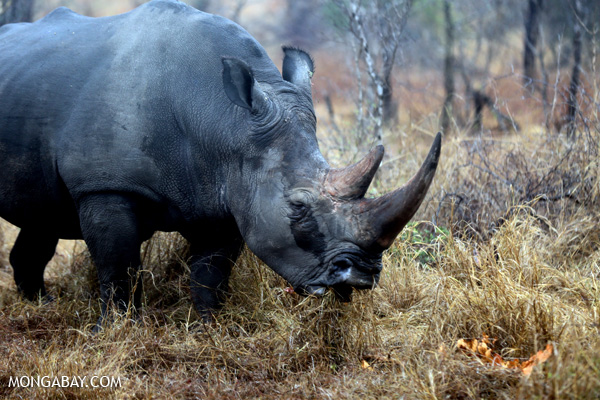 WARNING: graphic image below. White rhino in South Africa. Photo by: Rhett A. Butler. South Africa has surpassed last year’s grisly record for slaughtered rhinos—1,004—more than a month before the year ends. In an announcement on November 20th, the South African Department of Environmental Affairs said that 1,020 rhinos had been killed to date. Rhinos […]
WARNING: graphic image below. White rhino in South Africa. Photo by: Rhett A. Butler. South Africa has surpassed last year’s grisly record for slaughtered rhinos—1,004—more than a month before the year ends. In an announcement on November 20th, the South African Department of Environmental Affairs said that 1,020 rhinos had been killed to date. Rhinos […]
Use of mammals still prevalent in Brazil’s Conservation Units
 For as long as humans and animals have co-existed, people have utilized them as resources. Animals, and their parts, have been used for a variety of purposes, ranging from basic food to more esoteric practices such as in magical ceremonies or religion. A new study published in mongabay.com‘s open-access journal Tropical Conservation Science has found […]
For as long as humans and animals have co-existed, people have utilized them as resources. Animals, and their parts, have been used for a variety of purposes, ranging from basic food to more esoteric practices such as in magical ceremonies or religion. A new study published in mongabay.com‘s open-access journal Tropical Conservation Science has found […]
Officials bust one of the biggest players in illegal Indonesian manta ray trade
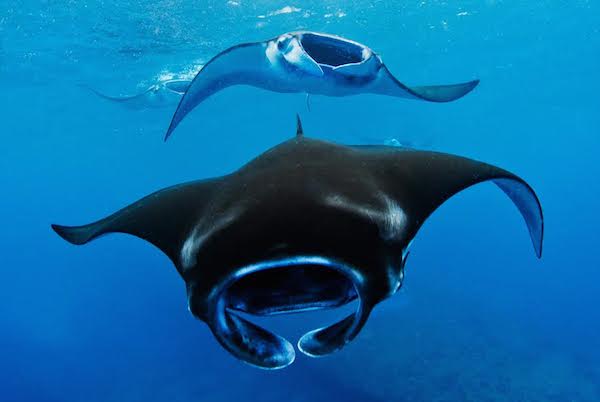 Exports of now-black market industry net $30M per year Writing this from a hotel room in Indonesia’s second-largest city, Surabaya, I realize that I am filled with trepidation as I wait for the phone next to me to ring. When it does, the voice on the other end will tell me it’s go time; the […]
Exports of now-black market industry net $30M per year Writing this from a hotel room in Indonesia’s second-largest city, Surabaya, I realize that I am filled with trepidation as I wait for the phone next to me to ring. When it does, the voice on the other end will tell me it’s go time; the […]
The threat of traditional medicine: China’s boom may mean doom for turtles
 Growing population and traditional mindset fueling demand for wild turtles, driving some species towards extinction For thousands of years turtles have been used in Chinese traditional medicine to treat a wide variety of ailments and diseases. Originally published in the journal Radiata and recently republished HerpDigest David S. Lee and Liao Shi Kun write, “[In […]
Growing population and traditional mindset fueling demand for wild turtles, driving some species towards extinction For thousands of years turtles have been used in Chinese traditional medicine to treat a wide variety of ailments and diseases. Originally published in the journal Radiata and recently republished HerpDigest David S. Lee and Liao Shi Kun write, “[In […]
Shot Egyptian vulture leads conservationists to bizarre black-market for bird parts
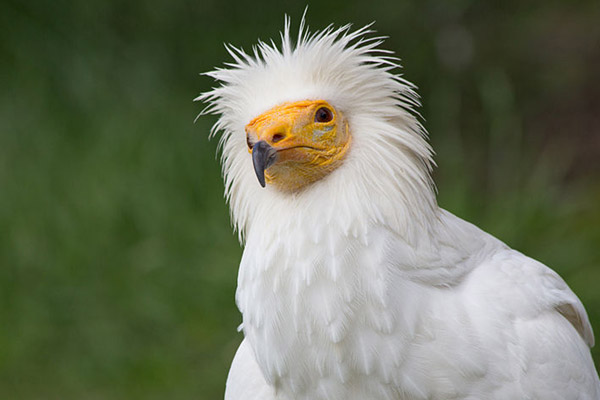 Captive Egyptian vulture adult. Photo by: Carlos Delgado/Creative Commons 3.0. The hunt Around 11 AM on Thursday, 27 February 2014, Angoulou Enika was lying hidden in the tall grass on the side of a large water hole in the Sahel region of Niger. He was staying as quiet as he could while aiming his custom-made […]
Captive Egyptian vulture adult. Photo by: Carlos Delgado/Creative Commons 3.0. The hunt Around 11 AM on Thursday, 27 February 2014, Angoulou Enika was lying hidden in the tall grass on the side of a large water hole in the Sahel region of Niger. He was staying as quiet as he could while aiming his custom-made […]
Rhino with bullet in its brain and hacked off horn wanders for days before being put down
 WARNING: graphic image below. Last week, visitors in Kruger National Park came on a horrifying sight of the poaching trade: a rhino, still alive, with its horn and part of its face chopped off. The gruesome photo of the young rhino went viral and sent South African authorities scrambling. Five days after the sighting, South […]
WARNING: graphic image below. Last week, visitors in Kruger National Park came on a horrifying sight of the poaching trade: a rhino, still alive, with its horn and part of its face chopped off. The gruesome photo of the young rhino went viral and sent South African authorities scrambling. Five days after the sighting, South […]
South Africa loses nearly 150 rhinos to poachers so far this year
 Since the first of the year, South Africa has lost 146 rhinos to poachers or approximately 2.5 rhinos every day. This is a slight dip from last year’s poaching rate, which hit 1,004 for the whole year or 2.75 a day. South Africa is home to more rhinos than any other country on the planet, […]
Since the first of the year, South Africa has lost 146 rhinos to poachers or approximately 2.5 rhinos every day. This is a slight dip from last year’s poaching rate, which hit 1,004 for the whole year or 2.75 a day. South Africa is home to more rhinos than any other country on the planet, […]
Over 1,000 rhinos killed by poachers in South Africa last year
 In another sign that Africa’s poaching crisis has gotten completely out of control, South Africa lost 1,004 rhinos to poachers last year. According to the numbers released today by the South African Department of Environmental Affairs, 2013 was the worst year yet for rhino poaching in the country with nearly 3 rhinos killed every day. […]
In another sign that Africa’s poaching crisis has gotten completely out of control, South Africa lost 1,004 rhinos to poachers last year. According to the numbers released today by the South African Department of Environmental Affairs, 2013 was the worst year yet for rhino poaching in the country with nearly 3 rhinos killed every day. […]
Six smugglers sentenced to jail time over pangolin trafficking in Malaysia
 Six men have been sentenced to a year in jail after being convicted of smuggling 150 pangolins in peninsular Malaysia, reports Annamiticus. The men were also given fines totaling over $100,000. Pangolins are small, scaly mammals that feed on termites much like South America’s anteaters. The animals are in demand for their scales, which are […]
Six men have been sentenced to a year in jail after being convicted of smuggling 150 pangolins in peninsular Malaysia, reports Annamiticus. The men were also given fines totaling over $100,000. Pangolins are small, scaly mammals that feed on termites much like South America’s anteaters. The animals are in demand for their scales, which are […]
Rhino slaughtered for its horn in city park
 In another sign that the rhino poaching crisis has gone out-of-control, Kenyan officials announced late last night that a pregnant rhino was poached in Nairobi National Park, which sits on the edge of Kenya’s capital. Home to lions, leopard, giraffes and hippos in addition to rhinos, the park is known for its views of iconic […]
In another sign that the rhino poaching crisis has gone out-of-control, Kenyan officials announced late last night that a pregnant rhino was poached in Nairobi National Park, which sits on the edge of Kenya’s capital. Home to lions, leopard, giraffes and hippos in addition to rhinos, the park is known for its views of iconic […]
Zoos call on governments to take urgent action against illegal wildlife trade (photos)
 Warning: some photos may be disturbing or graphic. In a single night in March, a band of heavily-armed, horse-riding poachers slaughtered 89 elephants in southern Chad, thirty of which were pregnant females. The carnage was the worst poaching incident of the year, but even this slaughter paled in comparison to the 650 elephants killed in […]
Warning: some photos may be disturbing or graphic. In a single night in March, a band of heavily-armed, horse-riding poachers slaughtered 89 elephants in southern Chad, thirty of which were pregnant females. The carnage was the worst poaching incident of the year, but even this slaughter paled in comparison to the 650 elephants killed in […]
First ever pangolin conference concludes all eight species in trouble
 Demand for scales, meat, and even fetuses of pangolins have pushed all eight species of this unique mammalian order—Pholidota—toward extinction, according to the world’s first ever pangolin conference with the International Union for Conservation of Nature – Species Survival Commission (IUCN-SSC) Pangolin Specialist Group. Meeting in Singapore earlier this month, 40 conservationists from 14 countries […]
Demand for scales, meat, and even fetuses of pangolins have pushed all eight species of this unique mammalian order—Pholidota—toward extinction, according to the world’s first ever pangolin conference with the International Union for Conservation of Nature – Species Survival Commission (IUCN-SSC) Pangolin Specialist Group. Meeting in Singapore earlier this month, 40 conservationists from 14 countries […]
Loris champion: conserving the world’s most surprising primate family
 The 2013 Zoos and Aquariums: Committing to Conservation (ZACC) conference runs from July 8th—July 12th in Des Moines, Iowa, hosted by the Blank Park Zoo. Ahead of the event, Mongabay.com is running a series of Q&As with presenters. For more interviews, please see our ZACC feed. Close-up of Javan slow loris (Nycticebus javanicus), listed as […]
The 2013 Zoos and Aquariums: Committing to Conservation (ZACC) conference runs from July 8th—July 12th in Des Moines, Iowa, hosted by the Blank Park Zoo. Ahead of the event, Mongabay.com is running a series of Q&As with presenters. For more interviews, please see our ZACC feed. Close-up of Javan slow loris (Nycticebus javanicus), listed as […]
Manta ray tourism worth 28 times more than killing them for Traditional Chinese Medicine
 A new study in the open access journal PLoS ONE estimates that manta rays are worth $140 million a year in tourism across 23 countries, significantly outweighing the worth of manta ray gill plates, which have become the newest craze in Traditional Chinese Medicine. “As an example in Indonesia, revenue to fishermen from manta gill […]
A new study in the open access journal PLoS ONE estimates that manta rays are worth $140 million a year in tourism across 23 countries, significantly outweighing the worth of manta ray gill plates, which have become the newest craze in Traditional Chinese Medicine. “As an example in Indonesia, revenue to fishermen from manta gill […]
Prince Charles: take the war to the poachers
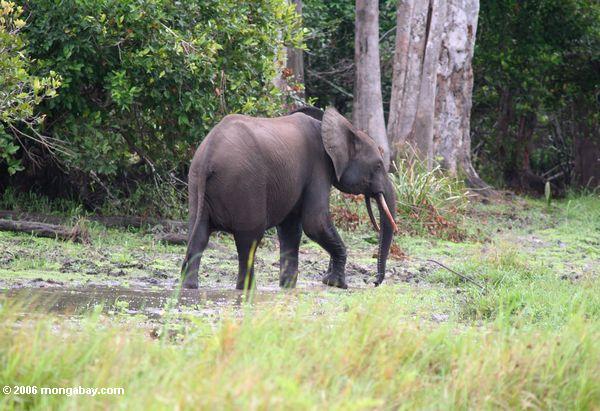 Prince Charles has warned that criminal gangs are turning to animal poaching, an unprecedented slaughter of species that can only be stopped by waging war on the perpetrators, in the latest of a series of increasingly outspoken speeches about the environment. Addressing a conference of conservationists at St James’s Palace in London, the Prince of […]
Prince Charles has warned that criminal gangs are turning to animal poaching, an unprecedented slaughter of species that can only be stopped by waging war on the perpetrators, in the latest of a series of increasingly outspoken speeches about the environment. Addressing a conference of conservationists at St James’s Palace in London, the Prince of […]
Rhino horn madness: over two rhinos killed a day in South Africa
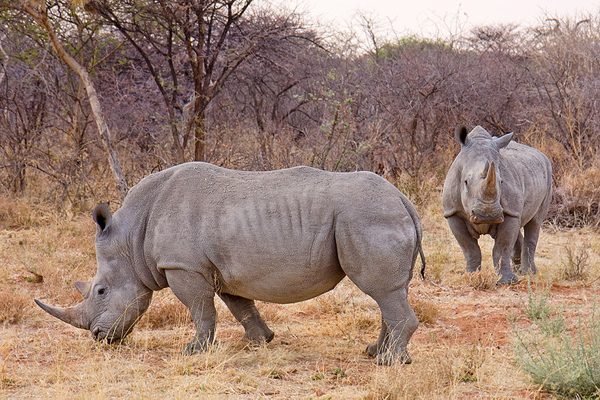 Rhino poachers have killed 232 rhinos during 2013 so far in South Africa, reports Annamiticus, which averages out to 2.1 a day. The country has become a flashpoint for rhino poaching as it holds more rhinos than any other country on Earth. Rhinos are being slaughter for their horns, which are believed to be a […]
Rhino poachers have killed 232 rhinos during 2013 so far in South Africa, reports Annamiticus, which averages out to 2.1 a day. The country has become a flashpoint for rhino poaching as it holds more rhinos than any other country on Earth. Rhinos are being slaughter for their horns, which are believed to be a […]
Lions for sale: big game hunting combines with lion bone trade to threaten endangered cats
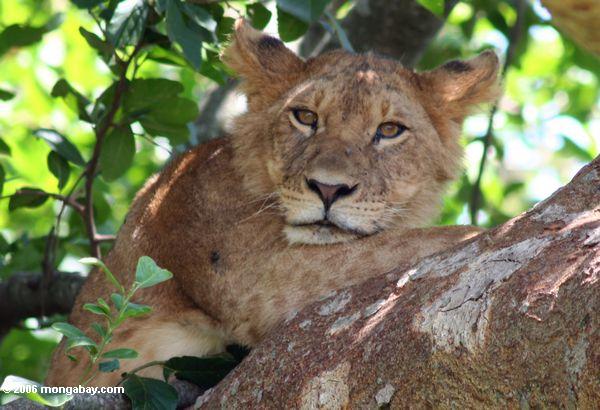 Koos Hermanus would rather not give names to the lions he breeds. So here, behind a 2.4-meter high electric fence, is 1R, a three-and-a-half-year-old male, who consumes 5kg of meat a day and weighs almost 200kg. It will only leave its enclosure once it has been “booked”‘ by a hunter, most of whom are from […]
Koos Hermanus would rather not give names to the lions he breeds. So here, behind a 2.4-meter high electric fence, is 1R, a three-and-a-half-year-old male, who consumes 5kg of meat a day and weighs almost 200kg. It will only leave its enclosure once it has been “booked”‘ by a hunter, most of whom are from […]
Double bad: Chinese vessel that collided with protected coral reef holding 22,000 pounds of pangolin meat
 What do you do when you’re smuggling 22,000 pounds of an endangered species on your boat? Answer: crash into a protected coral reef in the Philippines. Last Monday a Chinese vessel slammed into a coral reef in the Tubbataha National Marine Park; on Saturday the Filipino coastguard discovered 400 boxes of pangolin meat while inspecting […]
What do you do when you’re smuggling 22,000 pounds of an endangered species on your boat? Answer: crash into a protected coral reef in the Philippines. Last Monday a Chinese vessel slammed into a coral reef in the Tubbataha National Marine Park; on Saturday the Filipino coastguard discovered 400 boxes of pangolin meat while inspecting […]
Pity the pangolin: little-known mammal most common victim of the wildlife trade
 World Pangolin Day is celebrated this weekend: Saturday, February 16th, 2013 Last year tens-of-thousands of elephants and hundreds of rhinos were butchered to feed the growing appetite of the illegal wildlife trade. This black market, largely centered in East Asia, also devoured tigers, sharks, leopards, turtles, snakes, and hundreds of other animals. Estimated at $19 […]
World Pangolin Day is celebrated this weekend: Saturday, February 16th, 2013 Last year tens-of-thousands of elephants and hundreds of rhinos were butchered to feed the growing appetite of the illegal wildlife trade. This black market, largely centered in East Asia, also devoured tigers, sharks, leopards, turtles, snakes, and hundreds of other animals. Estimated at $19 […]
Asian bear farming: breaking the cycle of exploitation (warning: graphic images)
 Sun bear in a cage in Indonesia. Photo by: Chris R. Shepherd/TRAFFIC Southeast Asia. In the forests of Asia, bears are being captured. These captives will be sent to bear farms, most unregulated and illegal, where they will be kept alive in a small cage, locked away for life. Their bodies will be used as […]
Sun bear in a cage in Indonesia. Photo by: Chris R. Shepherd/TRAFFIC Southeast Asia. In the forests of Asia, bears are being captured. These captives will be sent to bear farms, most unregulated and illegal, where they will be kept alive in a small cage, locked away for life. Their bodies will be used as […]
Scary caterpillar fungus could lead to new cancer drug
 Caterpillars infected with Cordyceps sinensis, mostly whole. Photo by William Rafti of the William Rafti Institute. Cordyceps sinensis, commonly known as caterpillar fungus, may be a groundbreaking new treatment for a number of life-threatening conditions including asthma, kidney failure and cancer according to a paper recently published by The RNA Society. If you’re a caterpillar […]
Caterpillars infected with Cordyceps sinensis, mostly whole. Photo by William Rafti of the William Rafti Institute. Cordyceps sinensis, commonly known as caterpillar fungus, may be a groundbreaking new treatment for a number of life-threatening conditions including asthma, kidney failure and cancer according to a paper recently published by The RNA Society. If you’re a caterpillar […]
Leopard poaching is a bigger problem in India than previously believed
 Leopard skin. © TRAFFIC. A recent study conducted by wildlife trade monitoring group TRAFFIC uncovered unnerving statistics about the illegal trade of leopards (Panthera pardus) in India: at least four leopards have been poached every week for the past decade in the country. The study, entitled Illuminating the Blind Spot: A study on illegal trade […]
Leopard skin. © TRAFFIC. A recent study conducted by wildlife trade monitoring group TRAFFIC uncovered unnerving statistics about the illegal trade of leopards (Panthera pardus) in India: at least four leopards have been poached every week for the past decade in the country. The study, entitled Illuminating the Blind Spot: A study on illegal trade […]
South Africa hits another new record in rhino killings
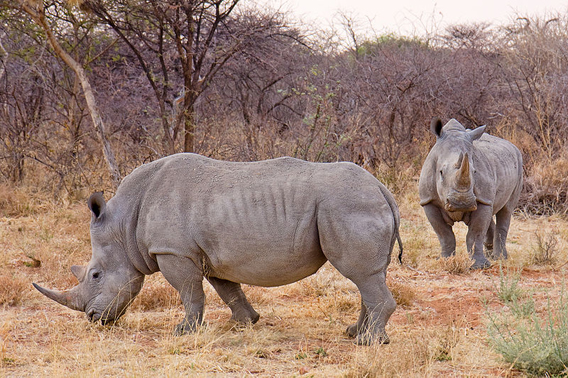 White rhinos in Namibia. White rhinos are the world’s most populous, but suffer massive poaching rates. Photo by: Ikiwaner. Four hundred and fifty-five rhinos have been killed by poachers in South Africa since the beginning of the year. The number surpasses the record set last year (448) and proves that national efforts to stem poaching […]
White rhinos in Namibia. White rhinos are the world’s most populous, but suffer massive poaching rates. Photo by: Ikiwaner. Four hundred and fifty-five rhinos have been killed by poachers in South Africa since the beginning of the year. The number surpasses the record set last year (448) and proves that national efforts to stem poaching […]
New website highlights the plight of the pangolin
GA_Sekkong-HKG_199305.568.jpg) The Chinese pangolin has recently been upgraded to Endangered on the IUCN Red List due to relentless poaching. Photo by: Gary Ades/KFBG. Scaly, insect-devouring, nocturnal, and notoriously shy, pangolins are strange mammals who remain unknown to many. But they are facing a major crisis as they are stolen from the wild in East Asia to […]
The Chinese pangolin has recently been upgraded to Endangered on the IUCN Red List due to relentless poaching. Photo by: Gary Ades/KFBG. Scaly, insect-devouring, nocturnal, and notoriously shy, pangolins are strange mammals who remain unknown to many. But they are facing a major crisis as they are stolen from the wild in East Asia to […]
Pictures of the day: pangolins saved in Thailand from poachers
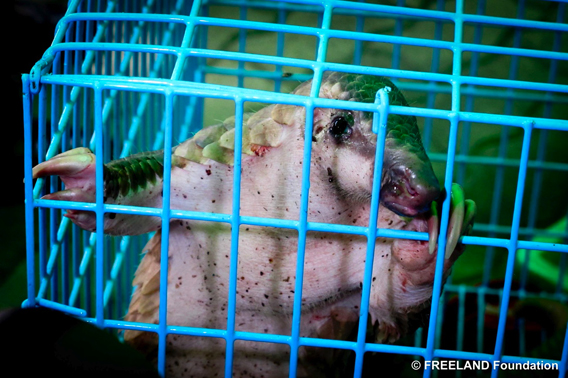 A rescued Sunda pangolin. Photo by: FREELAND Foundation. Earlier this summer, 110 Sunda pangolins (Manis javanica) were rescued by Thai customs officials from poachers in a pickup truck. While the driver of the vehicle escaped, a passenger was arrested, but released after paying a fine of $75,000, reports the NGO FREELAND Foundation. Pangolins are eaten […]
A rescued Sunda pangolin. Photo by: FREELAND Foundation. Earlier this summer, 110 Sunda pangolins (Manis javanica) were rescued by Thai customs officials from poachers in a pickup truck. While the driver of the vehicle escaped, a passenger was arrested, but released after paying a fine of $75,000, reports the NGO FREELAND Foundation. Pangolins are eaten […]
Hail Mary effort aims to save the world’s most endangered turtles
 Roti snake island turtle, which is number 12 of the world’s most endangered turtles, are being captive bred at the WCS’s Bronx Zoo. Photo by: Julie Larsen Maher/WCS. The Wildlife Conservation Society (WCS) has pledged to work with all of its institutions to save at least half of the world’s most 25 endangered turtles as […]
Roti snake island turtle, which is number 12 of the world’s most endangered turtles, are being captive bred at the WCS’s Bronx Zoo. Photo by: Julie Larsen Maher/WCS. The Wildlife Conservation Society (WCS) has pledged to work with all of its institutions to save at least half of the world’s most 25 endangered turtles as […]
Kruger National Park loses 95 rhinos to poachers in three months
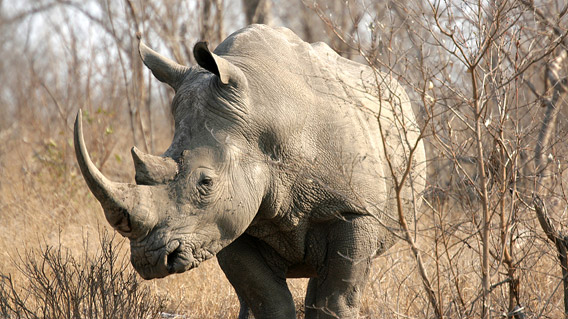 Rhinoceros, Kruger National Park, South Africa. A white rhinoceros (Ceratotherium simum) roaming Kruger, which is also home to the Critically Endangered black rhinoceros. Photo by: Bigstock. Since the first of the year, South Africa’s Kruger National Park has lost 95 rhinos to poachers, reports the blog Rhino Horn is NOT Medicine. South Africa, and Kruger […]
Rhinoceros, Kruger National Park, South Africa. A white rhinoceros (Ceratotherium simum) roaming Kruger, which is also home to the Critically Endangered black rhinoceros. Photo by: Bigstock. Since the first of the year, South Africa’s Kruger National Park has lost 95 rhinos to poachers, reports the blog Rhino Horn is NOT Medicine. South Africa, and Kruger […]
‘Where’s my mama?’: campaign targets cruel slow loris pet trade [warning: graphic photo]
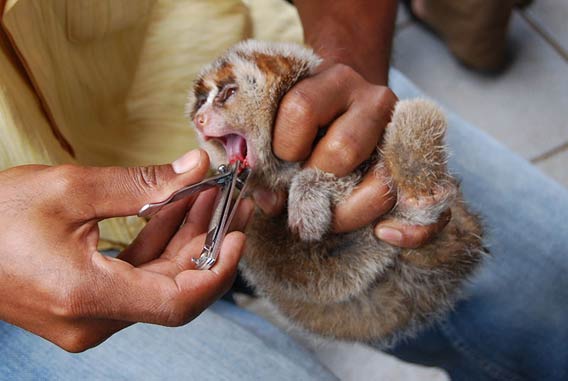 Slow lorises like this Sunda Slow Loris juvenile (Nycticebus coucang) have their teeth forcibly removed by animal traffickers in the open-air bird markets of Indonesia. The practice is done to either convince buyers that the animal is suitable as a child’s pet or to make people think the animal is an infant. This photo was […]
Slow lorises like this Sunda Slow Loris juvenile (Nycticebus coucang) have their teeth forcibly removed by animal traffickers in the open-air bird markets of Indonesia. The practice is done to either convince buyers that the animal is suitable as a child’s pet or to make people think the animal is an infant. This photo was […]
Majority of protected tropical forests “empty” due to hunting
 WARNING: Graphic photos below. Hunter in the Colombian rainforest. Photo by: Rhett A. Butler. Protected areas in the world’s tropical rainforests are absolutely essential, but one cannot simply set up a new refuge and believe the work is done, according to a new paper in Bioscience. Unsustainable hunting and poaching is decimating tropical forest species […]
WARNING: Graphic photos below. Hunter in the Colombian rainforest. Photo by: Rhett A. Butler. Protected areas in the world’s tropical rainforests are absolutely essential, but one cannot simply set up a new refuge and believe the work is done, according to a new paper in Bioscience. Unsustainable hunting and poaching is decimating tropical forest species […]
Sumatran rhino pregnant: conservationists hope third time’s the charm
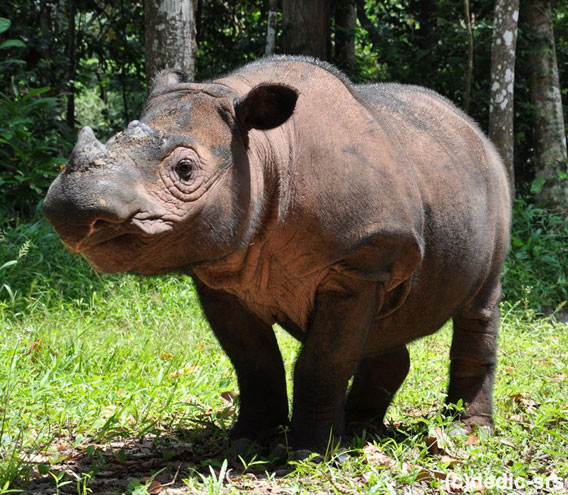 Conservationists hope Ratu, pictured above, has a successful third pregnancy. Photo by: International Rhino Foundation. Ratu, a female Sumatra rhino (Dicerorhinus sumatrensis), is in the eleventh month of her third pregnancy raising hopes for a successful birth of one of the world’s most imperiled big mammals. Ratu suffered two prior miscarriages, but researchers believe the […]
Conservationists hope Ratu, pictured above, has a successful third pregnancy. Photo by: International Rhino Foundation. Ratu, a female Sumatra rhino (Dicerorhinus sumatrensis), is in the eleventh month of her third pregnancy raising hopes for a successful birth of one of the world’s most imperiled big mammals. Ratu suffered two prior miscarriages, but researchers believe the […]
Vampire and bird frogs: discovering new amphibians in Southeast Asia’s threatened forests
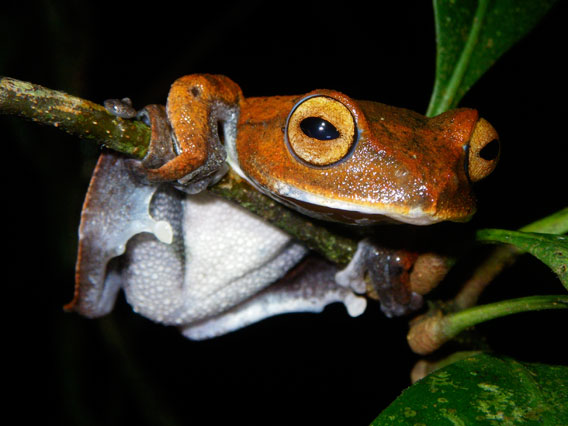 An interview with Jodi Rowley, a part of our on-going Interviews with Young Scientists series.
An interview with Jodi Rowley, a part of our on-going Interviews with Young Scientists series.
Pangolins imperiled by internet trade–are companies responding quickly enough?
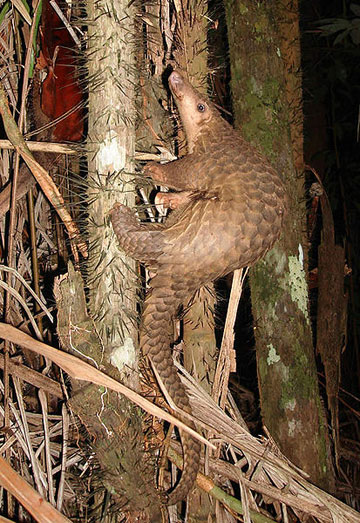 You can buy pretty much anything on the internet: from Rugby team garden gnomes to Mickey Mouse lingerie. In some places, consumers have even been able to purchase illegal wildlife parts, such as ivory and rhino horn. In fact, the internet has opened up the black market wildlife trade contributing to the destruction of biodiversity […]
You can buy pretty much anything on the internet: from Rugby team garden gnomes to Mickey Mouse lingerie. In some places, consumers have even been able to purchase illegal wildlife parts, such as ivory and rhino horn. In fact, the internet has opened up the black market wildlife trade contributing to the destruction of biodiversity […]
Happy rhino news: no rhinos poached in Nepal last year
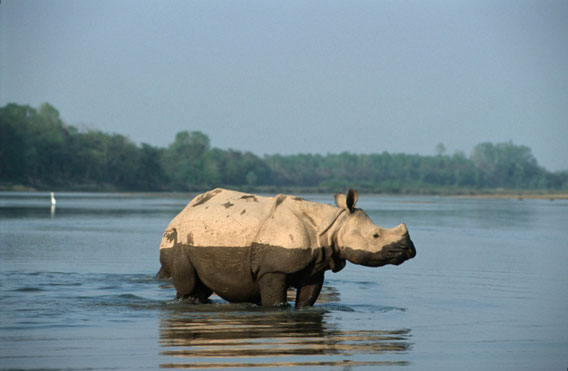 Greater one-horned rhino in Nepal. Photo courtesy of WWF. As rhinos again fell to poachers in record numbers in 2011, there was one bright-spot: Nepal. Not a single rhino was killed by poachers in the Himalayan nation, home to an estimated 534 greater one-horned rhinos (Rhinoceros unicornis), categorized as Vulnerable by the IUCN Red List. […]
Greater one-horned rhino in Nepal. Photo courtesy of WWF. As rhinos again fell to poachers in record numbers in 2011, there was one bright-spot: Nepal. Not a single rhino was killed by poachers in the Himalayan nation, home to an estimated 534 greater one-horned rhinos (Rhinoceros unicornis), categorized as Vulnerable by the IUCN Red List. […]
Top 10 Environmental Stories of 2011
 Victories won by activists around the world tops our list of the big environmental stories of the year. In this photo: a young woman is placed in handcuffs and arrested for civil disobedience against the Keystone XL Pipeline in the U.S. In all, 1,252 people were arrested in the two week long action. Photo by: […]
Victories won by activists around the world tops our list of the big environmental stories of the year. In this photo: a young woman is placed in handcuffs and arrested for civil disobedience against the Keystone XL Pipeline in the U.S. In all, 1,252 people were arrested in the two week long action. Photo by: […]
Photos: 208 species discovered in endangered Mekong region in 2010
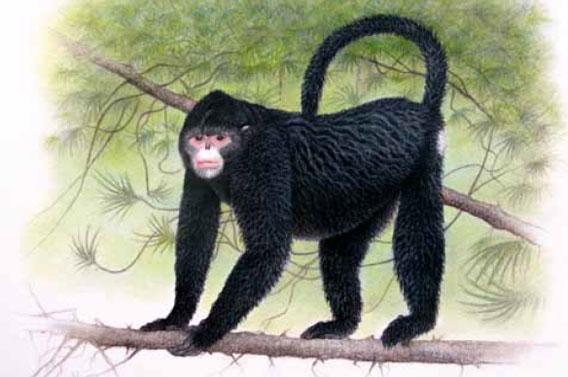 A new monkey, dubbed the Myanmar snub-nosed monkey (Rhinopithecus strykeri), was only discovered after researchers heard reports from hunters of a strange monkey with upturned nostrils and prominent lips in the remote Kachin region of Myanmar. It is known locally as mey nwoah, or ‘monkey with an upturned face’. Reportedly its easy to locate since […]
A new monkey, dubbed the Myanmar snub-nosed monkey (Rhinopithecus strykeri), was only discovered after researchers heard reports from hunters of a strange monkey with upturned nostrils and prominent lips in the remote Kachin region of Myanmar. It is known locally as mey nwoah, or ‘monkey with an upturned face’. Reportedly its easy to locate since […]
South Africa hits record poaching of rhinos—again
 WARNING: Graphic photo below. Indian rhino with its horn sawed off. A cut-off horn may help keep poachers away, but doesn’t guarantee it. Photo: Rhett A. Butler. Two months before the end of the year, the number of rhinos killed for their horns in South Africa has surpassed last year’s breaking record, reports conservation organizations […]
WARNING: Graphic photo below. Indian rhino with its horn sawed off. A cut-off horn may help keep poachers away, but doesn’t guarantee it. Photo: Rhett A. Butler. Two months before the end of the year, the number of rhinos killed for their horns in South Africa has surpassed last year’s breaking record, reports conservation organizations […]
Vietnamese rhino goes extinct
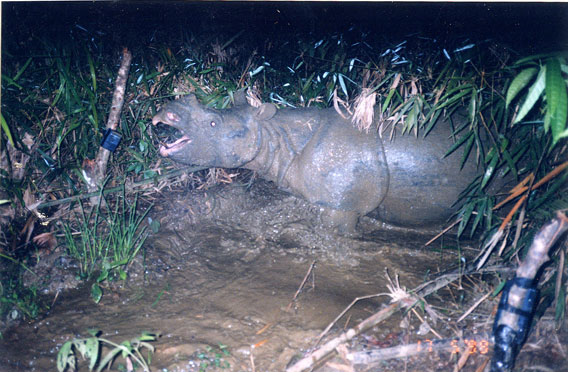 Camera trap catches one of the world’s last Vietnamese rhinos before its extinction. Photo courtesy of WWF. In 2009 poachers shot and killed the world’s last Vietnamese rhinoceros (Rhinoceros sondaicus annamiticus), a subspecies of the Javan rhino, confirms a report from International Rhino Foundation (IRF) and the World Wide Fund for Nature (WWF). The Vietnamese […]
Camera trap catches one of the world’s last Vietnamese rhinos before its extinction. Photo courtesy of WWF. In 2009 poachers shot and killed the world’s last Vietnamese rhinoceros (Rhinoceros sondaicus annamiticus), a subspecies of the Javan rhino, confirms a report from International Rhino Foundation (IRF) and the World Wide Fund for Nature (WWF). The Vietnamese […]
Cute animal picture of the day: ginger-haired baby monkey
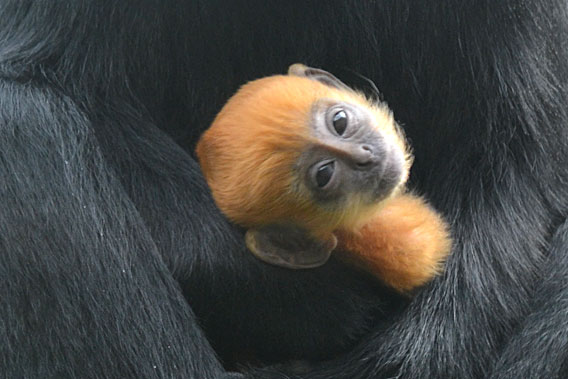 Baby Francois langur looking at the world at the London zoo. Photo courtesy of ZSL. One of the world’s most endangered primates recently gave birth to an orange-haired baby at the Zoological Society of London (ZSL) Zoo in London. It’s the mother Francois langur (Trachypithecus francoisi)’s first birth. The fire-orange hair of the baby is […]
Baby Francois langur looking at the world at the London zoo. Photo courtesy of ZSL. One of the world’s most endangered primates recently gave birth to an orange-haired baby at the Zoological Society of London (ZSL) Zoo in London. It’s the mother Francois langur (Trachypithecus francoisi)’s first birth. The fire-orange hair of the baby is […]
How do we save the Sumatran rhino?
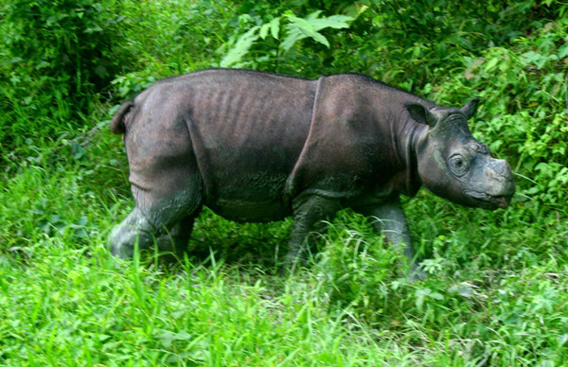 Tam, a male Sumatran rhino is kept in semi-captivity in Borneo with hopes to mate him with a female. The Sumatran rhinos on Borneo are actually a unique subspecies, dubbed the Borneo rhino, they are the world’s smallest.Photo by: Jeremy Hance. Some conservation challenges are more daunting than others. For example, how do you save […]
Tam, a male Sumatran rhino is kept in semi-captivity in Borneo with hopes to mate him with a female. The Sumatran rhinos on Borneo are actually a unique subspecies, dubbed the Borneo rhino, they are the world’s smallest.Photo by: Jeremy Hance. Some conservation challenges are more daunting than others. For example, how do you save […]
Bear bile trade, both legal and illegal, ubiquitous in Asia
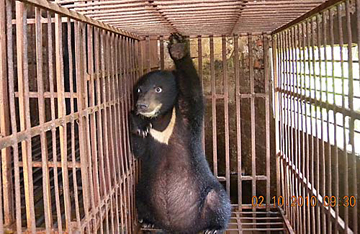 Surveying 13 nations and territories in Asia, the wildlife trade organization TRAFFIC found that the bear bile trade remains practically ubiquitous in the region. In many cases the trade, which extracts bile from captive bears’ gall bladders for sale as a pharmaceutical, flouts both local and international law, including Appendix I of Convention on International […]
Surveying 13 nations and territories in Asia, the wildlife trade organization TRAFFIC found that the bear bile trade remains practically ubiquitous in the region. In many cases the trade, which extracts bile from captive bears’ gall bladders for sale as a pharmaceutical, flouts both local and international law, including Appendix I of Convention on International […]
Cambodia’s wildlife pioneer: saving species and places in Southeast Asia’s last forest
- Suwanna Gauntlett has dedicated her life to protecting rainforests and wildlife in some of the world’s most hostile and rugged environments and has set the trend of a new generation of direct action conservationists.
- She has designed, implemented, and supported bold, front-line conservation programs to save endangered wildlife populations from the brink of extinction.
- When she first arrived in Cambodia in the late 1990s, its forests were silent.
New eco-tour to help save bizarre antelope in ‘forgotten’ region
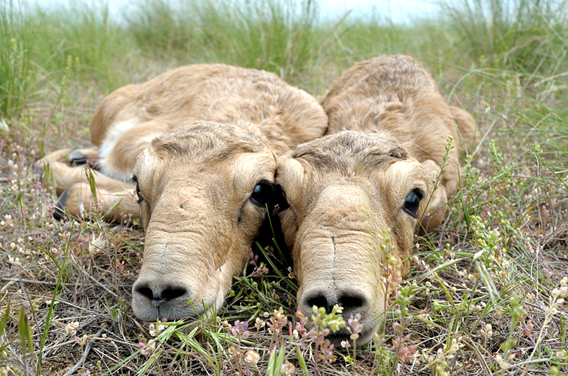 Saiga calves. Photo by: Igor Shpilenok. Imagine visiting a region that is largely void of tourists, yet has world-class bird watching, a unique Buddhist population, and one of the world’s most bizarre-looking and imperilled mammals: the saiga. A new tour to Southern Russia hopes to aid a Critically Endangered species while giving tourists an inside […]
Saiga calves. Photo by: Igor Shpilenok. Imagine visiting a region that is largely void of tourists, yet has world-class bird watching, a unique Buddhist population, and one of the world’s most bizarre-looking and imperilled mammals: the saiga. A new tour to Southern Russia hopes to aid a Critically Endangered species while giving tourists an inside […]
In spite of poaching, Nepal’s rhino population on the rise
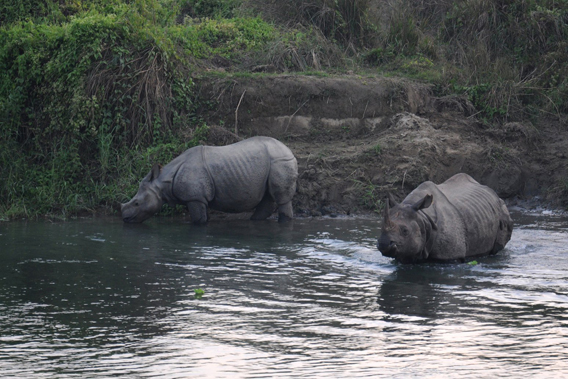 One-horned rhinos, or Indian rhinos, in Nepal’s Chitwan National Park. Photo by: Praveen Sharma/www.prveen.com . Good news for rhinos is rare recently, but a new census shows that Nepal’s one-horned rhino (Rhinoceros unicornis) population has increased by 23% since 2008 even in the face of poaching. In total 534 rhinos survive in Nepal, a rise […]
One-horned rhinos, or Indian rhinos, in Nepal’s Chitwan National Park. Photo by: Praveen Sharma/www.prveen.com . Good news for rhinos is rare recently, but a new census shows that Nepal’s one-horned rhino (Rhinoceros unicornis) population has increased by 23% since 2008 even in the face of poaching. In total 534 rhinos survive in Nepal, a rise […]
Pet trade, palm oil, and poaching: the challenges of saving the ‘forgotten bear’
 This interview is an excerpt from The WildLife with Laurel Neme, a program that explores the mysteries of the animal world through interviews with scientists and other wildlife investigators. “The WildLife” airs every Monday from 1-2 pm EST on WOMM-LP, 105.9 FM in Burlington, Vermont. You can livestream it at theradiator.org or download the podcast […]
This interview is an excerpt from The WildLife with Laurel Neme, a program that explores the mysteries of the animal world through interviews with scientists and other wildlife investigators. “The WildLife” airs every Monday from 1-2 pm EST on WOMM-LP, 105.9 FM in Burlington, Vermont. You can livestream it at theradiator.org or download the podcast […]
Video: camera trap proves world’s rarest rhino is breeding
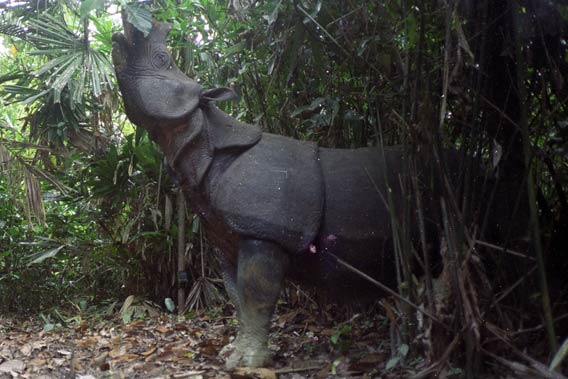 A Javan rhino (Rhinoceros sondaicus) captured on a camera trap browses for food. Javan rhinos are herbivores and eat around 110 lbs of food daily. Photo courtesy of WWF. There may only be 40 left in the world, but intimate footage of Javan rhino mothers and calves have been captured by video-camera trap in Ujung […]
A Javan rhino (Rhinoceros sondaicus) captured on a camera trap browses for food. Javan rhinos are herbivores and eat around 110 lbs of food daily. Photo courtesy of WWF. There may only be 40 left in the world, but intimate footage of Javan rhino mothers and calves have been captured by video-camera trap in Ujung […]
A lion’s story, an interview with the filmmakers of The Last Lions
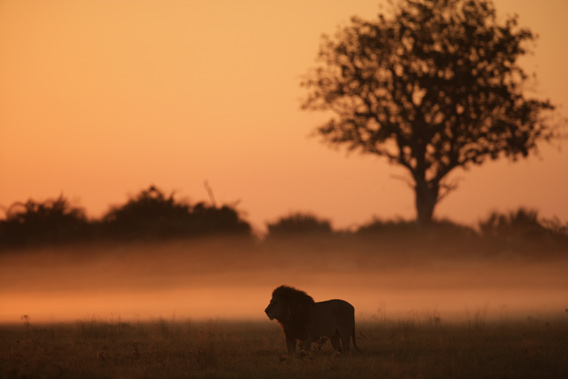 Male lion in the Okavango Delta. © National Geographic Entertainment. Photo by: Beverly Joubert . The new theatrical film, The Last Lions does not open, as one would expect, with a shot of lions or even an African panorama. Instead the first shot is a view of our planet from space at night. Billions of […]
Male lion in the Okavango Delta. © National Geographic Entertainment. Photo by: Beverly Joubert . The new theatrical film, The Last Lions does not open, as one would expect, with a shot of lions or even an African panorama. Instead the first shot is a view of our planet from space at night. Billions of […]
Rhino horn price matches cocaine
 As a rhino poaching epidemic continues throughout Africa and Asia, the price of rhino horn has matched cocaine, according to the UK’s Daily Mirror. The price of illegal powdered rhino horn—obtained by killing wild rhinos and sawing off their horns—has hit £31,000 per kilo or nearly $50,000 per kilo. The price has already topped that […]
As a rhino poaching epidemic continues throughout Africa and Asia, the price of rhino horn has matched cocaine, according to the UK’s Daily Mirror. The price of illegal powdered rhino horn—obtained by killing wild rhinos and sawing off their horns—has hit £31,000 per kilo or nearly $50,000 per kilo. The price has already topped that […]
World’s weirdest aphrodisiac: elephant-digested durian fruit
 The spiky, odorous, weighty, and almost impenetrable durian fruit is considered by some to be a fine delicacy, but others a putrid horror. Its taste has been described between a delicious custard and old gym socks. Still, even durian lovers may be uncomfortable with the idea of eating the fruit after it has been consumed […]
The spiky, odorous, weighty, and almost impenetrable durian fruit is considered by some to be a fine delicacy, but others a putrid horror. Its taste has been described between a delicious custard and old gym socks. Still, even durian lovers may be uncomfortable with the idea of eating the fruit after it has been consumed […]
Tiger summit reaches bold agreement and raises $300 million
 The summit to save the world’s biggest cat, and one of the world’s most popular animals, has agreed to a bold plan dubbed the Global Tiger Recovery Program. Meeting in St. Petersburg, 13 nations have set a goal to double the wild tiger’s (Panthera tigris) population worldwide by 2022. Given that tiger numbers continue to […]
The summit to save the world’s biggest cat, and one of the world’s most popular animals, has agreed to a bold plan dubbed the Global Tiger Recovery Program. Meeting in St. Petersburg, 13 nations have set a goal to double the wild tiger’s (Panthera tigris) population worldwide by 2022. Given that tiger numbers continue to […]
Photos: wild, weird, and rare mammals storm the conservation world
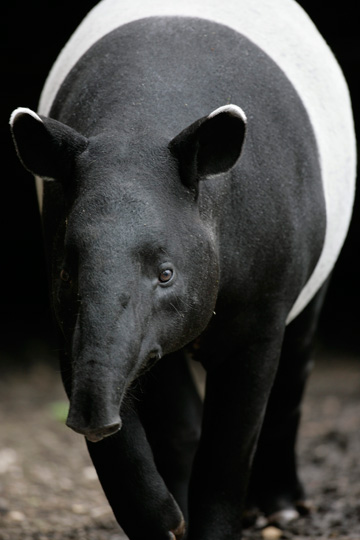 The conservation program, EDGE, takes a second look at the world’s unique and threatened mammals. What do the New Zealand greater short-tailed bat, the black-and-white ruffed lemur, and the numbat have in common? They are all new members of the Zoological Society of London’s EDGE’s top 100 most endangered and unique mammals list. Arguably the […]
The conservation program, EDGE, takes a second look at the world’s unique and threatened mammals. What do the New Zealand greater short-tailed bat, the black-and-white ruffed lemur, and the numbat have in common? They are all new members of the Zoological Society of London’s EDGE’s top 100 most endangered and unique mammals list. Arguably the […]
Botanist killed in crossfire in Philippines
A local botanist was killed in crossfire between the Filipino military and suspected communist guerrillas with the New People’s Army on Monday, reports the Inquirer.net. Leonardo L. Co, a botanist, working at the time with the Energy Development Corp. (EDC), was reportedly collecting seeds from an endangered tree when he, as well as an engineer […]
Alleged rhino horn dealer takes his own life
 The illegal trade in rhino horn doesn’t just end in the deaths of thousands of rhinos. Humans, too, often lose their lives in the trade. Both those poaching rhinos and those protecting them, such as park rangers, have been killed in gun battles. But the trade ruins lives in many ways: yesterday, Tommy Fourie, 51, […]
The illegal trade in rhino horn doesn’t just end in the deaths of thousands of rhinos. Humans, too, often lose their lives in the trade. Both those poaching rhinos and those protecting them, such as park rangers, have been killed in gun battles. But the trade ruins lives in many ways: yesterday, Tommy Fourie, 51, […]
Authorities confiscated over 1000 tigers in past decade
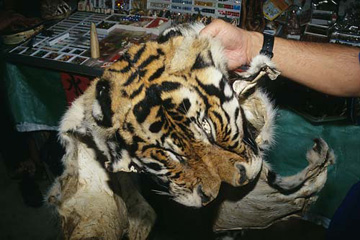 Highlighting the poaching crisis facing tigers, a new report by the wildlife trade organization, TRAFFIC, found that from 2000-2010 authorities have confiscated the parts of 1,069 tiger individuals, many of them dead. The tigers, or their body parts, were confiscated from 11 of the species’ 13 range countries, according to the report entitled Reduced to […]
Highlighting the poaching crisis facing tigers, a new report by the wildlife trade organization, TRAFFIC, found that from 2000-2010 authorities have confiscated the parts of 1,069 tiger individuals, many of them dead. The tigers, or their body parts, were confiscated from 11 of the species’ 13 range countries, according to the report entitled Reduced to […]
Undercover for animals: on the frontline of wildlife crime in the US
 US Fish and Wildlife Service Special Agent Sheila O’Connor revealed the inside story of working in wildlife law enforcement to Laurel Neme on her “The WildLife” radio show and podcast. In the first of a two-part interview, Special Agent O’Connor talks about her adventures stopping wildlife crime—scoping out pet shops in the Chicago area for […]
US Fish and Wildlife Service Special Agent Sheila O’Connor revealed the inside story of working in wildlife law enforcement to Laurel Neme on her “The WildLife” radio show and podcast. In the first of a two-part interview, Special Agent O’Connor talks about her adventures stopping wildlife crime—scoping out pet shops in the Chicago area for […]
Feeds: news | india | latam | brasil | indonesia
 WARNING: graphic image below. White rhino in South Africa. Photo by: Rhett A. Butler. South Africa has surpassed last year’s grisly record for slaughtered rhinos—1,004—more than a month before the year ends. In an announcement on November 20th, the South African Department of Environmental Affairs said that 1,020 rhinos had been killed to date. Rhinos […]
WARNING: graphic image below. White rhino in South Africa. Photo by: Rhett A. Butler. South Africa has surpassed last year’s grisly record for slaughtered rhinos—1,004—more than a month before the year ends. In an announcement on November 20th, the South African Department of Environmental Affairs said that 1,020 rhinos had been killed to date. Rhinos […] For as long as humans and animals have co-existed, people have utilized them as resources. Animals, and their parts, have been used for a variety of purposes, ranging from basic food to more esoteric practices such as in magical ceremonies or religion. A new study published in mongabay.com‘s open-access journal Tropical Conservation Science has found […]
For as long as humans and animals have co-existed, people have utilized them as resources. Animals, and their parts, have been used for a variety of purposes, ranging from basic food to more esoteric practices such as in magical ceremonies or religion. A new study published in mongabay.com‘s open-access journal Tropical Conservation Science has found […] Exports of now-black market industry net $30M per year Writing this from a hotel room in Indonesia’s second-largest city, Surabaya, I realize that I am filled with trepidation as I wait for the phone next to me to ring. When it does, the voice on the other end will tell me it’s go time; the […]
Exports of now-black market industry net $30M per year Writing this from a hotel room in Indonesia’s second-largest city, Surabaya, I realize that I am filled with trepidation as I wait for the phone next to me to ring. When it does, the voice on the other end will tell me it’s go time; the […] Growing population and traditional mindset fueling demand for wild turtles, driving some species towards extinction For thousands of years turtles have been used in Chinese traditional medicine to treat a wide variety of ailments and diseases. Originally published in the journal Radiata and recently republished HerpDigest David S. Lee and Liao Shi Kun write, “[In […]
Growing population and traditional mindset fueling demand for wild turtles, driving some species towards extinction For thousands of years turtles have been used in Chinese traditional medicine to treat a wide variety of ailments and diseases. Originally published in the journal Radiata and recently republished HerpDigest David S. Lee and Liao Shi Kun write, “[In […] Captive Egyptian vulture adult. Photo by: Carlos Delgado/Creative Commons 3.0. The hunt Around 11 AM on Thursday, 27 February 2014, Angoulou Enika was lying hidden in the tall grass on the side of a large water hole in the Sahel region of Niger. He was staying as quiet as he could while aiming his custom-made […]
Captive Egyptian vulture adult. Photo by: Carlos Delgado/Creative Commons 3.0. The hunt Around 11 AM on Thursday, 27 February 2014, Angoulou Enika was lying hidden in the tall grass on the side of a large water hole in the Sahel region of Niger. He was staying as quiet as he could while aiming his custom-made […] WARNING: graphic image below. Last week, visitors in Kruger National Park came on a horrifying sight of the poaching trade: a rhino, still alive, with its horn and part of its face chopped off. The gruesome photo of the young rhino went viral and sent South African authorities scrambling. Five days after the sighting, South […]
WARNING: graphic image below. Last week, visitors in Kruger National Park came on a horrifying sight of the poaching trade: a rhino, still alive, with its horn and part of its face chopped off. The gruesome photo of the young rhino went viral and sent South African authorities scrambling. Five days after the sighting, South […] Since the first of the year, South Africa has lost 146 rhinos to poachers or approximately 2.5 rhinos every day. This is a slight dip from last year’s poaching rate, which hit 1,004 for the whole year or 2.75 a day. South Africa is home to more rhinos than any other country on the planet, […]
Since the first of the year, South Africa has lost 146 rhinos to poachers or approximately 2.5 rhinos every day. This is a slight dip from last year’s poaching rate, which hit 1,004 for the whole year or 2.75 a day. South Africa is home to more rhinos than any other country on the planet, […] In another sign that Africa’s poaching crisis has gotten completely out of control, South Africa lost 1,004 rhinos to poachers last year. According to the numbers released today by the South African Department of Environmental Affairs, 2013 was the worst year yet for rhino poaching in the country with nearly 3 rhinos killed every day. […]
In another sign that Africa’s poaching crisis has gotten completely out of control, South Africa lost 1,004 rhinos to poachers last year. According to the numbers released today by the South African Department of Environmental Affairs, 2013 was the worst year yet for rhino poaching in the country with nearly 3 rhinos killed every day. […] Six men have been sentenced to a year in jail after being convicted of smuggling 150 pangolins in peninsular Malaysia, reports Annamiticus. The men were also given fines totaling over $100,000. Pangolins are small, scaly mammals that feed on termites much like South America’s anteaters. The animals are in demand for their scales, which are […]
Six men have been sentenced to a year in jail after being convicted of smuggling 150 pangolins in peninsular Malaysia, reports Annamiticus. The men were also given fines totaling over $100,000. Pangolins are small, scaly mammals that feed on termites much like South America’s anteaters. The animals are in demand for their scales, which are […] In another sign that the rhino poaching crisis has gone out-of-control, Kenyan officials announced late last night that a pregnant rhino was poached in Nairobi National Park, which sits on the edge of Kenya’s capital. Home to lions, leopard, giraffes and hippos in addition to rhinos, the park is known for its views of iconic […]
In another sign that the rhino poaching crisis has gone out-of-control, Kenyan officials announced late last night that a pregnant rhino was poached in Nairobi National Park, which sits on the edge of Kenya’s capital. Home to lions, leopard, giraffes and hippos in addition to rhinos, the park is known for its views of iconic […] Warning: some photos may be disturbing or graphic. In a single night in March, a band of heavily-armed, horse-riding poachers slaughtered 89 elephants in southern Chad, thirty of which were pregnant females. The carnage was the worst poaching incident of the year, but even this slaughter paled in comparison to the 650 elephants killed in […]
Warning: some photos may be disturbing or graphic. In a single night in March, a band of heavily-armed, horse-riding poachers slaughtered 89 elephants in southern Chad, thirty of which were pregnant females. The carnage was the worst poaching incident of the year, but even this slaughter paled in comparison to the 650 elephants killed in […] Demand for scales, meat, and even fetuses of pangolins have pushed all eight species of this unique mammalian order—Pholidota—toward extinction, according to the world’s first ever pangolin conference with the International Union for Conservation of Nature – Species Survival Commission (IUCN-SSC) Pangolin Specialist Group. Meeting in Singapore earlier this month, 40 conservationists from 14 countries […]
Demand for scales, meat, and even fetuses of pangolins have pushed all eight species of this unique mammalian order—Pholidota—toward extinction, according to the world’s first ever pangolin conference with the International Union for Conservation of Nature – Species Survival Commission (IUCN-SSC) Pangolin Specialist Group. Meeting in Singapore earlier this month, 40 conservationists from 14 countries […] The 2013 Zoos and Aquariums: Committing to Conservation (ZACC) conference runs from July 8th—July 12th in Des Moines, Iowa, hosted by the Blank Park Zoo. Ahead of the event, Mongabay.com is running a series of Q&As with presenters. For more interviews, please see our ZACC feed. Close-up of Javan slow loris (Nycticebus javanicus), listed as […]
The 2013 Zoos and Aquariums: Committing to Conservation (ZACC) conference runs from July 8th—July 12th in Des Moines, Iowa, hosted by the Blank Park Zoo. Ahead of the event, Mongabay.com is running a series of Q&As with presenters. For more interviews, please see our ZACC feed. Close-up of Javan slow loris (Nycticebus javanicus), listed as […] A new study in the open access journal PLoS ONE estimates that manta rays are worth $140 million a year in tourism across 23 countries, significantly outweighing the worth of manta ray gill plates, which have become the newest craze in Traditional Chinese Medicine. “As an example in Indonesia, revenue to fishermen from manta gill […]
A new study in the open access journal PLoS ONE estimates that manta rays are worth $140 million a year in tourism across 23 countries, significantly outweighing the worth of manta ray gill plates, which have become the newest craze in Traditional Chinese Medicine. “As an example in Indonesia, revenue to fishermen from manta gill […] Prince Charles has warned that criminal gangs are turning to animal poaching, an unprecedented slaughter of species that can only be stopped by waging war on the perpetrators, in the latest of a series of increasingly outspoken speeches about the environment. Addressing a conference of conservationists at St James’s Palace in London, the Prince of […]
Prince Charles has warned that criminal gangs are turning to animal poaching, an unprecedented slaughter of species that can only be stopped by waging war on the perpetrators, in the latest of a series of increasingly outspoken speeches about the environment. Addressing a conference of conservationists at St James’s Palace in London, the Prince of […] Rhino poachers have killed 232 rhinos during 2013 so far in South Africa, reports Annamiticus, which averages out to 2.1 a day. The country has become a flashpoint for rhino poaching as it holds more rhinos than any other country on Earth. Rhinos are being slaughter for their horns, which are believed to be a […]
Rhino poachers have killed 232 rhinos during 2013 so far in South Africa, reports Annamiticus, which averages out to 2.1 a day. The country has become a flashpoint for rhino poaching as it holds more rhinos than any other country on Earth. Rhinos are being slaughter for their horns, which are believed to be a […] Koos Hermanus would rather not give names to the lions he breeds. So here, behind a 2.4-meter high electric fence, is 1R, a three-and-a-half-year-old male, who consumes 5kg of meat a day and weighs almost 200kg. It will only leave its enclosure once it has been “booked”‘ by a hunter, most of whom are from […]
Koos Hermanus would rather not give names to the lions he breeds. So here, behind a 2.4-meter high electric fence, is 1R, a three-and-a-half-year-old male, who consumes 5kg of meat a day and weighs almost 200kg. It will only leave its enclosure once it has been “booked”‘ by a hunter, most of whom are from […] What do you do when you’re smuggling 22,000 pounds of an endangered species on your boat? Answer: crash into a protected coral reef in the Philippines. Last Monday a Chinese vessel slammed into a coral reef in the Tubbataha National Marine Park; on Saturday the Filipino coastguard discovered 400 boxes of pangolin meat while inspecting […]
What do you do when you’re smuggling 22,000 pounds of an endangered species on your boat? Answer: crash into a protected coral reef in the Philippines. Last Monday a Chinese vessel slammed into a coral reef in the Tubbataha National Marine Park; on Saturday the Filipino coastguard discovered 400 boxes of pangolin meat while inspecting […] World Pangolin Day is celebrated this weekend: Saturday, February 16th, 2013 Last year tens-of-thousands of elephants and hundreds of rhinos were butchered to feed the growing appetite of the illegal wildlife trade. This black market, largely centered in East Asia, also devoured tigers, sharks, leopards, turtles, snakes, and hundreds of other animals. Estimated at $19 […]
World Pangolin Day is celebrated this weekend: Saturday, February 16th, 2013 Last year tens-of-thousands of elephants and hundreds of rhinos were butchered to feed the growing appetite of the illegal wildlife trade. This black market, largely centered in East Asia, also devoured tigers, sharks, leopards, turtles, snakes, and hundreds of other animals. Estimated at $19 […] Sun bear in a cage in Indonesia. Photo by: Chris R. Shepherd/TRAFFIC Southeast Asia. In the forests of Asia, bears are being captured. These captives will be sent to bear farms, most unregulated and illegal, where they will be kept alive in a small cage, locked away for life. Their bodies will be used as […]
Sun bear in a cage in Indonesia. Photo by: Chris R. Shepherd/TRAFFIC Southeast Asia. In the forests of Asia, bears are being captured. These captives will be sent to bear farms, most unregulated and illegal, where they will be kept alive in a small cage, locked away for life. Their bodies will be used as […] Caterpillars infected with Cordyceps sinensis, mostly whole. Photo by William Rafti of the William Rafti Institute. Cordyceps sinensis, commonly known as caterpillar fungus, may be a groundbreaking new treatment for a number of life-threatening conditions including asthma, kidney failure and cancer according to a paper recently published by The RNA Society. If you’re a caterpillar […]
Caterpillars infected with Cordyceps sinensis, mostly whole. Photo by William Rafti of the William Rafti Institute. Cordyceps sinensis, commonly known as caterpillar fungus, may be a groundbreaking new treatment for a number of life-threatening conditions including asthma, kidney failure and cancer according to a paper recently published by The RNA Society. If you’re a caterpillar […] Leopard skin. © TRAFFIC. A recent study conducted by wildlife trade monitoring group TRAFFIC uncovered unnerving statistics about the illegal trade of leopards (Panthera pardus) in India: at least four leopards have been poached every week for the past decade in the country. The study, entitled Illuminating the Blind Spot: A study on illegal trade […]
Leopard skin. © TRAFFIC. A recent study conducted by wildlife trade monitoring group TRAFFIC uncovered unnerving statistics about the illegal trade of leopards (Panthera pardus) in India: at least four leopards have been poached every week for the past decade in the country. The study, entitled Illuminating the Blind Spot: A study on illegal trade […] White rhinos in Namibia. White rhinos are the world’s most populous, but suffer massive poaching rates. Photo by: Ikiwaner. Four hundred and fifty-five rhinos have been killed by poachers in South Africa since the beginning of the year. The number surpasses the record set last year (448) and proves that national efforts to stem poaching […]
White rhinos in Namibia. White rhinos are the world’s most populous, but suffer massive poaching rates. Photo by: Ikiwaner. Four hundred and fifty-five rhinos have been killed by poachers in South Africa since the beginning of the year. The number surpasses the record set last year (448) and proves that national efforts to stem poaching […]GA_Sekkong-HKG_199305.568.jpg) The Chinese pangolin has recently been upgraded to Endangered on the IUCN Red List due to relentless poaching. Photo by: Gary Ades/KFBG. Scaly, insect-devouring, nocturnal, and notoriously shy, pangolins are strange mammals who remain unknown to many. But they are facing a major crisis as they are stolen from the wild in East Asia to […]
The Chinese pangolin has recently been upgraded to Endangered on the IUCN Red List due to relentless poaching. Photo by: Gary Ades/KFBG. Scaly, insect-devouring, nocturnal, and notoriously shy, pangolins are strange mammals who remain unknown to many. But they are facing a major crisis as they are stolen from the wild in East Asia to […] A rescued Sunda pangolin. Photo by: FREELAND Foundation. Earlier this summer, 110 Sunda pangolins (Manis javanica) were rescued by Thai customs officials from poachers in a pickup truck. While the driver of the vehicle escaped, a passenger was arrested, but released after paying a fine of $75,000, reports the NGO FREELAND Foundation. Pangolins are eaten […]
A rescued Sunda pangolin. Photo by: FREELAND Foundation. Earlier this summer, 110 Sunda pangolins (Manis javanica) were rescued by Thai customs officials from poachers in a pickup truck. While the driver of the vehicle escaped, a passenger was arrested, but released after paying a fine of $75,000, reports the NGO FREELAND Foundation. Pangolins are eaten […] Roti snake island turtle, which is number 12 of the world’s most endangered turtles, are being captive bred at the WCS’s Bronx Zoo. Photo by: Julie Larsen Maher/WCS. The Wildlife Conservation Society (WCS) has pledged to work with all of its institutions to save at least half of the world’s most 25 endangered turtles as […]
Roti snake island turtle, which is number 12 of the world’s most endangered turtles, are being captive bred at the WCS’s Bronx Zoo. Photo by: Julie Larsen Maher/WCS. The Wildlife Conservation Society (WCS) has pledged to work with all of its institutions to save at least half of the world’s most 25 endangered turtles as […] Rhinoceros, Kruger National Park, South Africa. A white rhinoceros (Ceratotherium simum) roaming Kruger, which is also home to the Critically Endangered black rhinoceros. Photo by: Bigstock. Since the first of the year, South Africa’s Kruger National Park has lost 95 rhinos to poachers, reports the blog Rhino Horn is NOT Medicine. South Africa, and Kruger […]
Rhinoceros, Kruger National Park, South Africa. A white rhinoceros (Ceratotherium simum) roaming Kruger, which is also home to the Critically Endangered black rhinoceros. Photo by: Bigstock. Since the first of the year, South Africa’s Kruger National Park has lost 95 rhinos to poachers, reports the blog Rhino Horn is NOT Medicine. South Africa, and Kruger […] Slow lorises like this Sunda Slow Loris juvenile (Nycticebus coucang) have their teeth forcibly removed by animal traffickers in the open-air bird markets of Indonesia. The practice is done to either convince buyers that the animal is suitable as a child’s pet or to make people think the animal is an infant. This photo was […]
Slow lorises like this Sunda Slow Loris juvenile (Nycticebus coucang) have their teeth forcibly removed by animal traffickers in the open-air bird markets of Indonesia. The practice is done to either convince buyers that the animal is suitable as a child’s pet or to make people think the animal is an infant. This photo was […] WARNING: Graphic photos below. Hunter in the Colombian rainforest. Photo by: Rhett A. Butler. Protected areas in the world’s tropical rainforests are absolutely essential, but one cannot simply set up a new refuge and believe the work is done, according to a new paper in Bioscience. Unsustainable hunting and poaching is decimating tropical forest species […]
WARNING: Graphic photos below. Hunter in the Colombian rainforest. Photo by: Rhett A. Butler. Protected areas in the world’s tropical rainforests are absolutely essential, but one cannot simply set up a new refuge and believe the work is done, according to a new paper in Bioscience. Unsustainable hunting and poaching is decimating tropical forest species […] Conservationists hope Ratu, pictured above, has a successful third pregnancy. Photo by: International Rhino Foundation. Ratu, a female Sumatra rhino (Dicerorhinus sumatrensis), is in the eleventh month of her third pregnancy raising hopes for a successful birth of one of the world’s most imperiled big mammals. Ratu suffered two prior miscarriages, but researchers believe the […]
Conservationists hope Ratu, pictured above, has a successful third pregnancy. Photo by: International Rhino Foundation. Ratu, a female Sumatra rhino (Dicerorhinus sumatrensis), is in the eleventh month of her third pregnancy raising hopes for a successful birth of one of the world’s most imperiled big mammals. Ratu suffered two prior miscarriages, but researchers believe the […] An interview with Jodi Rowley, a part of our on-going Interviews with Young Scientists series.
An interview with Jodi Rowley, a part of our on-going Interviews with Young Scientists series. You can buy pretty much anything on the internet: from Rugby team garden gnomes to Mickey Mouse lingerie. In some places, consumers have even been able to purchase illegal wildlife parts, such as ivory and rhino horn. In fact, the internet has opened up the black market wildlife trade contributing to the destruction of biodiversity […]
You can buy pretty much anything on the internet: from Rugby team garden gnomes to Mickey Mouse lingerie. In some places, consumers have even been able to purchase illegal wildlife parts, such as ivory and rhino horn. In fact, the internet has opened up the black market wildlife trade contributing to the destruction of biodiversity […] Greater one-horned rhino in Nepal. Photo courtesy of WWF. As rhinos again fell to poachers in record numbers in 2011, there was one bright-spot: Nepal. Not a single rhino was killed by poachers in the Himalayan nation, home to an estimated 534 greater one-horned rhinos (Rhinoceros unicornis), categorized as Vulnerable by the IUCN Red List. […]
Greater one-horned rhino in Nepal. Photo courtesy of WWF. As rhinos again fell to poachers in record numbers in 2011, there was one bright-spot: Nepal. Not a single rhino was killed by poachers in the Himalayan nation, home to an estimated 534 greater one-horned rhinos (Rhinoceros unicornis), categorized as Vulnerable by the IUCN Red List. […] Victories won by activists around the world tops our list of the big environmental stories of the year. In this photo: a young woman is placed in handcuffs and arrested for civil disobedience against the Keystone XL Pipeline in the U.S. In all, 1,252 people were arrested in the two week long action. Photo by: […]
Victories won by activists around the world tops our list of the big environmental stories of the year. In this photo: a young woman is placed in handcuffs and arrested for civil disobedience against the Keystone XL Pipeline in the U.S. In all, 1,252 people were arrested in the two week long action. Photo by: […] A new monkey, dubbed the Myanmar snub-nosed monkey (Rhinopithecus strykeri), was only discovered after researchers heard reports from hunters of a strange monkey with upturned nostrils and prominent lips in the remote Kachin region of Myanmar. It is known locally as mey nwoah, or ‘monkey with an upturned face’. Reportedly its easy to locate since […]
A new monkey, dubbed the Myanmar snub-nosed monkey (Rhinopithecus strykeri), was only discovered after researchers heard reports from hunters of a strange monkey with upturned nostrils and prominent lips in the remote Kachin region of Myanmar. It is known locally as mey nwoah, or ‘monkey with an upturned face’. Reportedly its easy to locate since […] Camera trap catches one of the world’s last Vietnamese rhinos before its extinction. Photo courtesy of WWF. In 2009 poachers shot and killed the world’s last Vietnamese rhinoceros (Rhinoceros sondaicus annamiticus), a subspecies of the Javan rhino, confirms a report from International Rhino Foundation (IRF) and the World Wide Fund for Nature (WWF). The Vietnamese […]
Camera trap catches one of the world’s last Vietnamese rhinos before its extinction. Photo courtesy of WWF. In 2009 poachers shot and killed the world’s last Vietnamese rhinoceros (Rhinoceros sondaicus annamiticus), a subspecies of the Javan rhino, confirms a report from International Rhino Foundation (IRF) and the World Wide Fund for Nature (WWF). The Vietnamese […] Baby Francois langur looking at the world at the London zoo. Photo courtesy of ZSL. One of the world’s most endangered primates recently gave birth to an orange-haired baby at the Zoological Society of London (ZSL) Zoo in London. It’s the mother Francois langur (Trachypithecus francoisi)’s first birth. The fire-orange hair of the baby is […]
Baby Francois langur looking at the world at the London zoo. Photo courtesy of ZSL. One of the world’s most endangered primates recently gave birth to an orange-haired baby at the Zoological Society of London (ZSL) Zoo in London. It’s the mother Francois langur (Trachypithecus francoisi)’s first birth. The fire-orange hair of the baby is […] Tam, a male Sumatran rhino is kept in semi-captivity in Borneo with hopes to mate him with a female. The Sumatran rhinos on Borneo are actually a unique subspecies, dubbed the Borneo rhino, they are the world’s smallest.Photo by: Jeremy Hance. Some conservation challenges are more daunting than others. For example, how do you save […]
Tam, a male Sumatran rhino is kept in semi-captivity in Borneo with hopes to mate him with a female. The Sumatran rhinos on Borneo are actually a unique subspecies, dubbed the Borneo rhino, they are the world’s smallest.Photo by: Jeremy Hance. Some conservation challenges are more daunting than others. For example, how do you save […] Surveying 13 nations and territories in Asia, the wildlife trade organization TRAFFIC found that the bear bile trade remains practically ubiquitous in the region. In many cases the trade, which extracts bile from captive bears’ gall bladders for sale as a pharmaceutical, flouts both local and international law, including Appendix I of Convention on International […]
Surveying 13 nations and territories in Asia, the wildlife trade organization TRAFFIC found that the bear bile trade remains practically ubiquitous in the region. In many cases the trade, which extracts bile from captive bears’ gall bladders for sale as a pharmaceutical, flouts both local and international law, including Appendix I of Convention on International […] Saiga calves. Photo by: Igor Shpilenok. Imagine visiting a region that is largely void of tourists, yet has world-class bird watching, a unique Buddhist population, and one of the world’s most bizarre-looking and imperilled mammals: the saiga. A new tour to Southern Russia hopes to aid a Critically Endangered species while giving tourists an inside […]
Saiga calves. Photo by: Igor Shpilenok. Imagine visiting a region that is largely void of tourists, yet has world-class bird watching, a unique Buddhist population, and one of the world’s most bizarre-looking and imperilled mammals: the saiga. A new tour to Southern Russia hopes to aid a Critically Endangered species while giving tourists an inside […] One-horned rhinos, or Indian rhinos, in Nepal’s Chitwan National Park. Photo by: Praveen Sharma/www.prveen.com . Good news for rhinos is rare recently, but a new census shows that Nepal’s one-horned rhino (Rhinoceros unicornis) population has increased by 23% since 2008 even in the face of poaching. In total 534 rhinos survive in Nepal, a rise […]
One-horned rhinos, or Indian rhinos, in Nepal’s Chitwan National Park. Photo by: Praveen Sharma/www.prveen.com . Good news for rhinos is rare recently, but a new census shows that Nepal’s one-horned rhino (Rhinoceros unicornis) population has increased by 23% since 2008 even in the face of poaching. In total 534 rhinos survive in Nepal, a rise […] This interview is an excerpt from The WildLife with Laurel Neme, a program that explores the mysteries of the animal world through interviews with scientists and other wildlife investigators. “The WildLife” airs every Monday from 1-2 pm EST on WOMM-LP, 105.9 FM in Burlington, Vermont. You can livestream it at theradiator.org or download the podcast […]
This interview is an excerpt from The WildLife with Laurel Neme, a program that explores the mysteries of the animal world through interviews with scientists and other wildlife investigators. “The WildLife” airs every Monday from 1-2 pm EST on WOMM-LP, 105.9 FM in Burlington, Vermont. You can livestream it at theradiator.org or download the podcast […] A Javan rhino (Rhinoceros sondaicus) captured on a camera trap browses for food. Javan rhinos are herbivores and eat around 110 lbs of food daily. Photo courtesy of WWF. There may only be 40 left in the world, but intimate footage of Javan rhino mothers and calves have been captured by video-camera trap in Ujung […]
A Javan rhino (Rhinoceros sondaicus) captured on a camera trap browses for food. Javan rhinos are herbivores and eat around 110 lbs of food daily. Photo courtesy of WWF. There may only be 40 left in the world, but intimate footage of Javan rhino mothers and calves have been captured by video-camera trap in Ujung […] Male lion in the Okavango Delta. © National Geographic Entertainment. Photo by: Beverly Joubert . The new theatrical film, The Last Lions does not open, as one would expect, with a shot of lions or even an African panorama. Instead the first shot is a view of our planet from space at night. Billions of […]
Male lion in the Okavango Delta. © National Geographic Entertainment. Photo by: Beverly Joubert . The new theatrical film, The Last Lions does not open, as one would expect, with a shot of lions or even an African panorama. Instead the first shot is a view of our planet from space at night. Billions of […] As a rhino poaching epidemic continues throughout Africa and Asia, the price of rhino horn has matched cocaine, according to the UK’s Daily Mirror. The price of illegal powdered rhino horn—obtained by killing wild rhinos and sawing off their horns—has hit £31,000 per kilo or nearly $50,000 per kilo. The price has already topped that […]
As a rhino poaching epidemic continues throughout Africa and Asia, the price of rhino horn has matched cocaine, according to the UK’s Daily Mirror. The price of illegal powdered rhino horn—obtained by killing wild rhinos and sawing off their horns—has hit £31,000 per kilo or nearly $50,000 per kilo. The price has already topped that […] The spiky, odorous, weighty, and almost impenetrable durian fruit is considered by some to be a fine delicacy, but others a putrid horror. Its taste has been described between a delicious custard and old gym socks. Still, even durian lovers may be uncomfortable with the idea of eating the fruit after it has been consumed […]
The spiky, odorous, weighty, and almost impenetrable durian fruit is considered by some to be a fine delicacy, but others a putrid horror. Its taste has been described between a delicious custard and old gym socks. Still, even durian lovers may be uncomfortable with the idea of eating the fruit after it has been consumed […] The summit to save the world’s biggest cat, and one of the world’s most popular animals, has agreed to a bold plan dubbed the Global Tiger Recovery Program. Meeting in St. Petersburg, 13 nations have set a goal to double the wild tiger’s (Panthera tigris) population worldwide by 2022. Given that tiger numbers continue to […]
The summit to save the world’s biggest cat, and one of the world’s most popular animals, has agreed to a bold plan dubbed the Global Tiger Recovery Program. Meeting in St. Petersburg, 13 nations have set a goal to double the wild tiger’s (Panthera tigris) population worldwide by 2022. Given that tiger numbers continue to […] The conservation program, EDGE, takes a second look at the world’s unique and threatened mammals. What do the New Zealand greater short-tailed bat, the black-and-white ruffed lemur, and the numbat have in common? They are all new members of the Zoological Society of London’s EDGE’s top 100 most endangered and unique mammals list. Arguably the […]
The conservation program, EDGE, takes a second look at the world’s unique and threatened mammals. What do the New Zealand greater short-tailed bat, the black-and-white ruffed lemur, and the numbat have in common? They are all new members of the Zoological Society of London’s EDGE’s top 100 most endangered and unique mammals list. Arguably the […] The illegal trade in rhino horn doesn’t just end in the deaths of thousands of rhinos. Humans, too, often lose their lives in the trade. Both those poaching rhinos and those protecting them, such as park rangers, have been killed in gun battles. But the trade ruins lives in many ways: yesterday, Tommy Fourie, 51, […]
The illegal trade in rhino horn doesn’t just end in the deaths of thousands of rhinos. Humans, too, often lose their lives in the trade. Both those poaching rhinos and those protecting them, such as park rangers, have been killed in gun battles. But the trade ruins lives in many ways: yesterday, Tommy Fourie, 51, […] Highlighting the poaching crisis facing tigers, a new report by the wildlife trade organization, TRAFFIC, found that from 2000-2010 authorities have confiscated the parts of 1,069 tiger individuals, many of them dead. The tigers, or their body parts, were confiscated from 11 of the species’ 13 range countries, according to the report entitled Reduced to […]
Highlighting the poaching crisis facing tigers, a new report by the wildlife trade organization, TRAFFIC, found that from 2000-2010 authorities have confiscated the parts of 1,069 tiger individuals, many of them dead. The tigers, or their body parts, were confiscated from 11 of the species’ 13 range countries, according to the report entitled Reduced to […] US Fish and Wildlife Service Special Agent Sheila O’Connor revealed the inside story of working in wildlife law enforcement to Laurel Neme on her “The WildLife” radio show and podcast. In the first of a two-part interview, Special Agent O’Connor talks about her adventures stopping wildlife crime—scoping out pet shops in the Chicago area for […]
US Fish and Wildlife Service Special Agent Sheila O’Connor revealed the inside story of working in wildlife law enforcement to Laurel Neme on her “The WildLife” radio show and podcast. In the first of a two-part interview, Special Agent O’Connor talks about her adventures stopping wildlife crime—scoping out pet shops in the Chicago area for […]